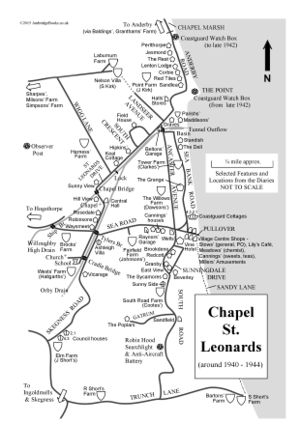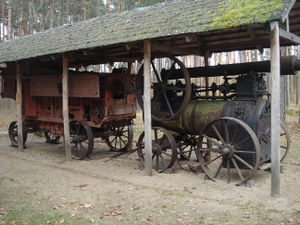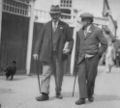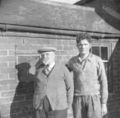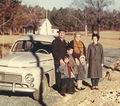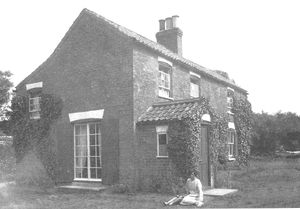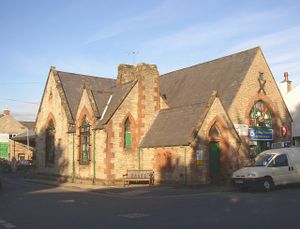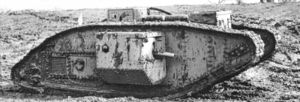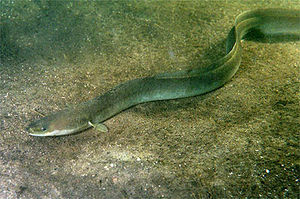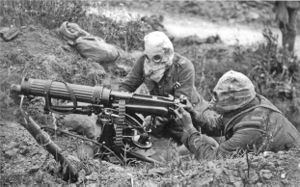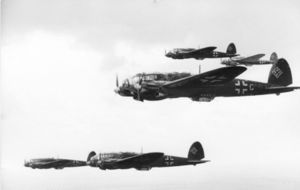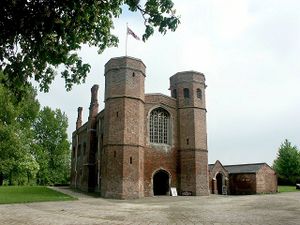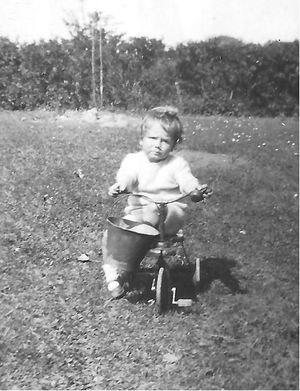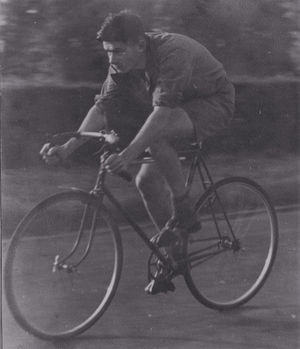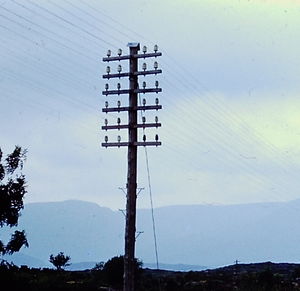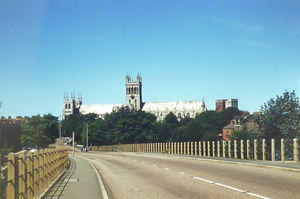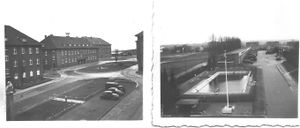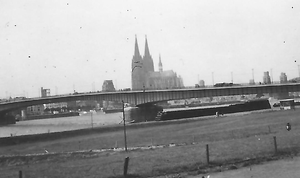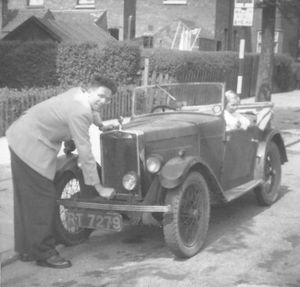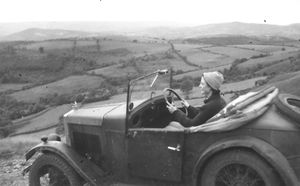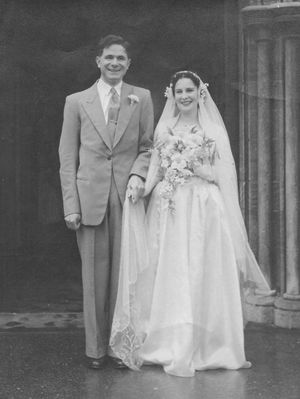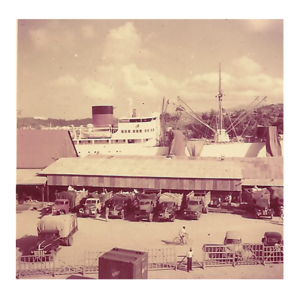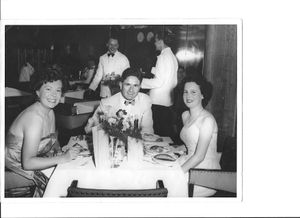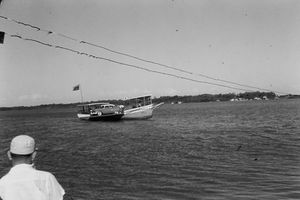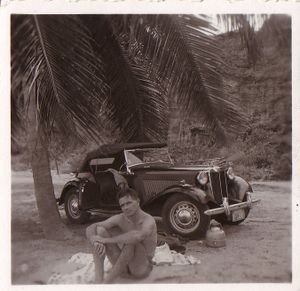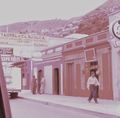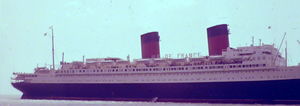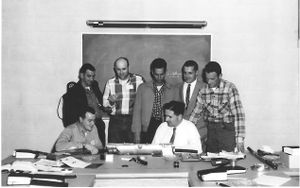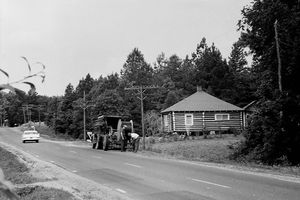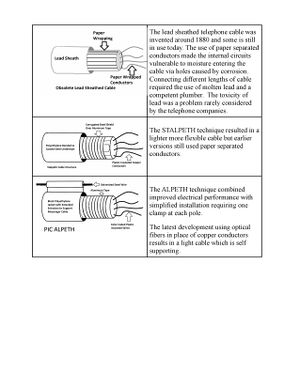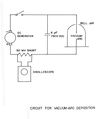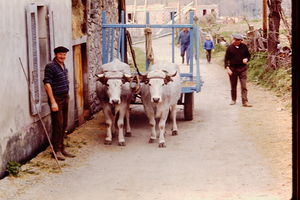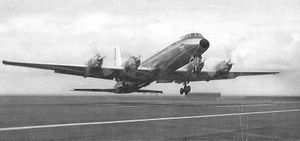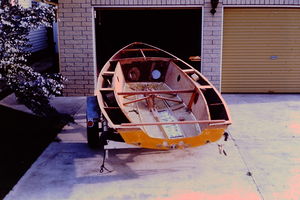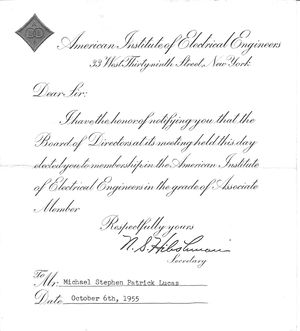First-Hand:Surfing the Waves of Technological Change. Part One: Difference between revisions
| Line 512: | Line 512: | ||
<gallery> | <gallery> | ||
File:Caracas_slum.JPG|Street Scene in poorer part of Caracas. | File:Caracas_slum.JPG|Street Scene in poorer part of Caracas. | ||
File: | File:Towers.JPG|My Office Building!Photograph aged badly. | ||
</gallery> | </gallery> | ||
Revision as of 14:12, 5 December 2016
Introduction to My Personal History
Michael S. P. Lucas, Life Fellow
It was with some trepidation that I decided to publish my memoirs. The detailed family version, Mirages of Memory was triggered by reading Uncle Tungsten: Memories of a Chemical Boyhood by Oliver Sacks. I found out that he was two years younger than me and grew up in London during WWII but we had similar experiences and interests although I grew up in the country.
In writing this earlier detailed, archival memoir I had noted that technological change and progress does not take place in a vacuum. There is a synergy between different fields, advances in one go hand in hand with those in others. For example the replacement of Transatlantic Ocean Liners with the Douglas DC 6 and Boeing 707 enabled European engineers and scientists to easily attend conferences in the USA and vice versa, thus disseminating engineering and scientific knowledge. Much later, the availability of the internet and VOIP communication systems enabled face-to-face discussions without leaving one’s office. Another observation was that technological advances usually build upon existing technology; for example, in the first automobiles the horses were replaced by a rudimentary steam or internal combustion engines resulting in strange looking horseless carriages.
My personal story is one of slowly evolving from an unaware but curious child user of simple technology ( mainly my father’s chisels, wood planes and hammer and nails), to become an apprentice telephone technician, an automatic telephone maintenance engineer and teacher, followed by a quantum jump to become a solid state researcher in thin films and superconductivity and eventually a professor of electrical and computer engineering specializing in instrumentation and measurements. These changes occurred over a span of seventy years. At an early age I had acquired a lifetime fascination with simple prototypes of emerging technologies. A few examples include flint arrowheads, longbows and crossbows, pendulum clocks, wood block prints, home made crystal sets and regenerative radio receivers. Many years later I became fascinated with DNA with its deceptively simple code, mysterious beginnings and incredible creations.
Chapel St. Leonards 1929 - 1937
Life at The Poplars
I was born in England in the County of Lincolnshire. My parents, Stephen Charles Lucas and Dorothy May Cook had been married for two years and living in The Poplars, an isolated ivy covered, red brick house built among the grassy fields, ditches and dykes of the Lincolnshire marshes. They were to live there for a decade. My siblings and I were born in The Poplars. I arrived in 1929, my sister Gabrielle in 1932 and brother Robin in 1936. The official registrations show the births occurring in the Sub-District of Alford. The village of Willoughby a short distance away, is in the same Sub-District and was the birthplace in 1580 of Captain John Smith of Jamestown, Virginia and Pocahontas fame. Another famous man from Lincolnshire was Sir Isaac Newton. John Harrison the clockmaker also came from Lincolnshire. Alford and Willoughby are both mentioned in the Domesday book but probably existed in prehistoric time and were renamed by the Danes after their 895 AD invasion and settlement of Lincolnshire.
According to William Henry Wheeler in A History of the Fens of South Lincolnshire, some time in the past Chapel St Leonards had been named Mumby-Chapel. In 1571 much of it was washed into the sea by a violent tempest. Only three cottages and the steeple of the church were left standing. This particular flood, one of many, was commemorated in Jean Ingelow’s poem 'High tide on the Lincolnshire Coast.
I have an early memory is of sitting inside a wooden child’s cot playing with a pack of cards. Later in my own bedroom I had a view of the Lincolnshire Wolds with clumps of trees darkening the hilltops followed by wonderful sunsets. Later but still at an early age I remember helping ‘Jarv’ Short, the nearby farmer, break ice on the water in the cattle troughs in the nearby field so his cattle could drink.
A more exciting memory was of a threshing machine coming by the house one dark, cold November evening. Clouds of sparks were flying from the coal fired, steam engine pulling the drum and elevator. [Picture] It was so cold that in order to see the machine my sister and I had to melt the frost off the windows in the kitchen with heated pennies.
More Pictures of Old Steam Engines
In the Spring Farmer Short would plough the field next to the house with two horses and a single blade plough. On one really exciting day there were two steam engines, one at each end of the field pulling a plough back and forth between them. The plough was fixed to a steel cable.
In the 1930’s The Poplars was an isolated, windswept, cold, redbrick building approached by a cart track from the East or across several fields from the Northwest. The cart track, also called the Gatrum or Gatrum Lane, was extremely rough with a pronounced hump in the middle and two deep ruts on either side. The other footpath across the fields eventually led to the school and village church after meandering over narrow planks across shallow drainage ditches and a larger bridge across the bigger Orby drain. Most of the fields were pasture and often contained grazing cattle and sometimes sheep. The ditches or in local parlance dykes were a small boy’s wonderland containing moorhens, coots, water rats, frogs and newts and sometimes a large pike.
The Poplars had no internal plumbing except for a hand pump in the kitchen drawing water from a hand dug, brick lined well. One wonders about the well and what was in it because one evening my mother had made herself some cocoa only to find a dead newt in the cup! A coal burning, black, cast iron cooking range in the kitchen contained a boiler for hot water, an oven for roasting and baking and various range top, hotplates for boiling and frying. A Primus stove provided boiling water for shaving and tea. With no electricity or gas, light came from an oil lamp or candles. The weekly bath took place in a tin bath in the kitchen. After the bath a ladder from the warm kitchen gave access to a bedroom above. Otherwise a staircase on the distant southwest corner of the house meant a cold trek through unheated rooms. The tiny grates in some of the bedrooms rarely had fires except to heat a sickroom. Nighttime plumbing consisted of chamber pots emptied in the morning. The double seated wooden outhouse on the south side of the house was emptied by a “dilly cart” pulled by a horse and emptied on various fields by the Night Soil man.
Laundry was washed by hand usually in a “copper” and agitated with a wooden dolly or ponch and wrung out with a hand wringer. The wet laundry was pegged on a clothesline west of the house and accessed by a plank across a ditch. The same ditch was also home to the family ducks. On many days no sooner was the washing pegged out than it would rain again. On a really bad day when the wind was from the East, soot from the kitchen range would get onto the clean washing. We used to say that the easterly winds came straight from Siberia.
We had a large garden with a chicken house and chicken run on the southern boundary next to a few poplar trees, a hawthorn hedge and a plum tree. At night the trees were home to what we knew as “screech owls” but were probably Little Owls. In the evening there were bats that sometimes got into the bedrooms through open windows. From time to time we would see a Kestrel hovering over the nearby field. On one occasion I saw one stoop to snatch a mouse out of some thick grass. Bumble Bees also nested in the thick grass. House sparrows and starlings fed with the chickens. From time to time there were flocks of rooks and lapwings in the fields and an occasional pair of carrion crows. Rarely, we would see a pair of black and grey hooded crows wintering away from a colder Scandinavia.
North of the house an old wooden garage contained garden tools, partially empty paint cans, a defunct BSA motor bike, carbide bicycle lamps, and containers of chicken feed. The real prize was a leather bandolier inside a metal cabin trunk. The bandolier and trunk were relicts of my paternal grandfather’s service in the Boer War - he was later killed at Arras. The garage was a welcome playhouse during bad weather. An incident that caused much family laughter was when I painted Jet, our black Newfoundland, with white paint. Saying that I wanted a white dog.
Winter was not an easy time for small children. We would play board games: Draughts, Snakes and Ladders and sometimes paint with watercolours. In the evenings we would have a variety of children’s books read to us. A.A. Milne’s, Winnie-the-Pooh, Lewis Carroll’s Alice in Wonderland, and the sequel Through the Looking Glass were particularly popular. Another child’s book seemed to be a fusion of Treasure Island and Peter Pan starring Captain Hook, Long John Silver, Tick-Tock the crocodile and Peter Pan. The first movie that I ever saw was the 1934 version of Treasure Island.
.
More Tenniel Drawings I have very hazy memories of early days at school. I first went to a small private school near my grandparents’ house and remember learning to write. Initially this consisted of drawing “pothooks” which looked like upside down question marks on special lined paper. Later we learned some cursive writing. More memorably I was harassed by two girls on the way to The Dell where my grandparents lived. The two girls in my class: Valerie Naylor and Diana Kirk would throw my satchel over a hedge and well out of my reach. I do not remember walking to school in the morning. At a later time I remember walking across the fields from The Poplars to the village school. On the way home in the afternoon I invariably fell into one of the many ditches soaking my boots and socks in the muddy ditchwater.
My father, Stephen Charles Lucas, was an orphan. His father who was a chef died at Arras in the Great War. He was a joiner and carpenter. He had trained as an apprentice with Joe Crawshaw a builder in Skegness and also the founder of an early Skegness Football Club. He later worked in construction at the new Butlin’s Holiday Camp. His younger brother Hedley Paget Lucas became a plumber and eventually worked for the Post Office Engineering Department as a cable jointer; this latter connection was to have a major influence on my later life.
My mother, born Dorothy May Cook in Grimsby, was the youngest in the family and a very bright student with a gift for remembering poetry. She began to train as a probationary nurse in Nottingham but did not finish presumably because she married my father. My mother supplemented the family income in the summer by taking in “Visitors” the local term for paying guests. I remember a Miss Ryalls and Miss Woodcock from Sheffield who would sometimes take my sister and me to the beach. For small children the beach was the place to make sandcastles, collect coloured stones and seashells and in September to go shrimping in the pools left by the outgoing tide. Sometimes there were crabs and dogfish stranded in the pools too. The footpath to the beach went past the DAKO camp, named after the Dako Street Lads' Club, from Dakeyne Street, Sneinton, Nottingham. In the summer the camp would be full of the old army style bell tents occupied by the Boys’ Brigade.
A Captain Dickens and his two boys were also from Sheffield . They were keen tennis players and exercised with indian clubs. We would also have various family groups from time to time. How on earth my mother managed to cook for them all I don’t know. However, some of them would help wash the dishes! Of course the main reason for visiting Chapel St. Leonards was to sunbathe on the beaches and swim in the sea. The beach holiday had been popularised by the Victorians because of the clean and healthy air as compared with the soot and smog in the towns.
Alfred Lord Tennyson who was Poet Laureate during much of Queen Victoria’s reign, was a frequent visitor to the coast. He too was born in Somersby, Lincolnshire and his favorite watering place was Mablethorpe. But he also recognized how cold and dreary the winters could be. For example the last four lines of his poem Mablethorpe:
Here often when a child I lay reclined:
I took delight in this fair land and;
Here stood the infant Ilion of the mind.
And here the Grecian ships all seemed to be.
And here again I come, and only find
The drain-cut level of the marshy lea,
Gray sand-banks, and pale sunsets, dreary wind,
Dim shores, dense rains, and heavy-clouded sea.
In the summer we would carry a basket of fresh eggs to Stow’s Grocery for him to sell to the holidaymakers. The shop was located in the old lifeboat house by the Pullover, in the village of Chapel St. Leonards. Otherwise we had home deliveries from Len Sharpe the greengrocer who came around with a horse and cart, Edgar the baker with a lorry, a milkman, and coalman, Percy Ranson, with a lorry. Butter, milk and cream we could also buy from a Mrs Beales on South Road. Mrs Beales made her own butter with milk from a Jersey Cow which produced extra creamy milk. Her dairy was fascinating because of the different tools and utensils used to separate the cream from the milk and churn it to butter. In the summer, if we got up early, we could gather fresh mushrooms from the adjoining fields and then eat them for breakfast with bacon and eggs. There were skylarks singing over the fields and many flowering Cowslips on the ditch banks. On one occasion a small plane landed in a nearby mushroom field and stayed overnight. Twice in 1936 we got up early in the morning to watch the brilliantly lit airship the Hindenberg fly over on its way to or from America. This was an amazing sight because of its size. In 1937 it caught fire in Lakehurst, NJ and was destroyed. My parents both recalled the Zeppelins dropping bombs during the Great War. They were attacking the British warships in the Humber.
The Dell 1938 - 1950
My grandparents lived in The Dell from 1921 to 1937. The Dell was warm and welcoming. It was protected from the cold easterly winds by sand dunes covered with thick bushes. Grandfather’s pride and joy a huge, six foot high, immaculate privet hedge protected the South and West. There were flower and vegetable plots and fruit trees too. There were electric lights and a few power outlets. It had a big new kitchen with running water from an outside tank. The tank was filled by hand pumping water from a well. Pumping was easier when the tide was in! There was also a large bathroom with a wash basin, water closet, and hot and cold water. The bathroom had both an outside door and an inside door which could lead to embarrassment for the person who forgot to lock the second door. On the south side of the house there was a glass greenhouse in which Grandpa Cook grew tomatoes for sale in the village.
In 1937 or 1938 we moved into The Dell and my grandparents moved to Cleethorpes, next door to their oldest son Stanley, a steam trawler skipper. So we now had a pleasant, comfortable house with a large garage next to the road. A bungalow at the back of the house about 36’ by 12’ which could be rented to visitors. We had our own pathway to the beach. Two half boat shelters stood on the back lawn. These were made by cutting an 18’ long wooden boat in half and standing each half vertically on the cut end. There were seats inside and they made good places for reading or just sitting and daydreaming. I vividly remember listening to Neville Chamberlain’s declaration of war speech on September 3rd 1939, a Sunday. I was seated in the half boat outside the kitchen window waiting for dinner.
There was also a large chicken run and a pigsty. An outside coal shed stood next to a toilet and laundry space. The latter contained an ancient copper and huge wringer or mangle with lignum vitae rollers. We did not have a car so the garage was used for bicycles, storage for my father’s tools a place for my woodworking projects, chemical experiments, white mice and eventually wireless experiments. It was usually ankle deep in wood shavings from my projects: swords, crossbows, and model boats and aeroplanes which I sold at Stowe’s shop.
There were several local features, waypoints in today’s GPS parlance, that the locals used for directions in the neighbourhood. The first was The Pullover which was a roadway over the sand dunes originally made to allow the lifeboat access to the sea. Chapel Point, to the North of The Dell, was a point with breakwaters which were covered by water on two sides at high tide. The Basin was the Outfall for the Orby and Willoughby drains. This was close to The Dell to the North. The Basin had big lock gates to prevent the high tides from flooding the land behind. The North Sea is very shallow and the tidal range from low to high can be as much as 30 feet. So The Basin is empty at low tide and full at high tide.
To the South of The Dell there were several red brick houses. The first was The Beacon, built on top of the sand dune. The next two buildings were substantial summer apartments built level with Sea Bank Road. The next house was built on the sand dune and belonged to John Henry Canning a local entrepreneur. It was interesting because of the special building at the back containing batteries charged by a Kansas style steel windmill. The last building was owned by a Mr. Rose from Gainsborough who with his brother was the inventor of a machine which individually wrapped chocolates, sweets and candies. Cadbury Roses are named after his company. He also owned a large american car.
Kindergarten and Elementary Schools 1934 - 1939.
The first school that I went to was a small, private kindergarten close to The Dell on Sea Bank Road. It is described on my first school report as follows: St. Leonard’s School, Chapel, Under London Board of Education E24/E40/3 Kindergarten, Michael Lucas, Age 5yrs 1mth, Summer 1934. Form Mistress and Principal both Miss Turney. According to my records I attended this school for two years 1934 and 1935.
My next school was the Public Elementary School built in Chapel St Leonards in 1876 to hold 65 children. The school was a typical Victorian building for the time: red brick with yellow brick decoration. There were two large playgrounds, the boys to the East and the girls to the West with separate outside toilets. This school was demolished and replaced with a new one. The photo shows a school of similar vintage.
To insert a time check with the world beyond Lincolnshire; the coronation of George VI and his wife Elizabeth as king and queen of the British Empire and Commonwealth Took place at Westminster Abbey, London, on 12 May 1937. There were also celebrations across the country and in the village of Chapel St Leonards they were held in Brock’s field. As I remember they held a sports day with various kinds of short races for the school children. At other times we would play Rounders and cricket in the same field. At this point my records and memory come up short. I believe that I attended the elementary school in Skegness for one year, 1936, but cannot confirm this. This is a case of a known Memory Mirage!
All of the students were in one large room. There was an entry porch on the North side and directly opposite by the South wall a large iron heating stove. The older boys had to bring in coal to stoke the stove. To the West of the stove and crossing the entire room was a brown curtain - the the five year olds or “babies” were behind the curtain, taught by Miss Hipkin. My sister says that she was very nice and a good teacher. The rest of the students were on the other side of the curtain taught by Mrs Pilgrim. Their ages varied from 6 to 11.
I have few memories of the school or of my fellow pupils. I do remember that there were some slates which beginning writers could use. Some heavily mutilated wooden desks with built in inkwells. There were very few books. I remember reading Black Beauty and trying to read a simplified version of The Vision of Piers Plowman to little effect! Multiplication tables were chanted by the entire class up to 12 times 12. My sister and I walked or ran home for lunch. The school was about three quarters of a mile from the Dell.
Family and Home Life
In addition to bus trips to Skegness we sometimes took longer trips to East Keal, a tiny village just past Spilsby. On the way before the war we would pass a field with several large artillery pieces and tanks from The Great War. These were removed and melted down for scrap when WW2 began. The Sykes house at East Keal was built on a hill next to the main road. In the distance one could see Boston Stump[2] on the horizon. In the field above the house there was a Spring with running water, something of great interest that I had never seen before.
Harry Sykes
Harry Sykes, the son of the house, had been in the Royal Navy when the Prince of Wales visited Hong Kong in 1922. While in Hong Kong Harry had a dragon tattooed on each arm, an act that he said he always regretted. In Hong Kong he acquired two small calendars with reproductions of Japanese Ukiyo-e, woodblock prints of the Floating World, and two imitation throwing knives which he gave to me. The prints were the first art books that I had seen except for the Tenniel drawings for Alice in Wonderland and they gave me a lifetime interest in woodblock printing and Ukiyo-e. Some of the ideas gleaned from woodblock printing were later applied to the production of electronic circuits. Harry was a most interesting mentor with a wide knowledge of books suitable for a teenage boy and the ability to explain how mechanical things work. He also gave me a starter collection of postage stamps and a variety of coins collected during his travels. One of his more interesting projects was the construction of a battery driven pendulum clock. He was also a keen cyclist and used to ride his Silver Fox bicycle from East Keal to Chapel St Leonards.
Books
I read extensively, some of the books must have come from the school but I do not know which ones. Frederick Marryat’s books were certainly on the list, for example: Mr Midshipman Easy, and Children of the New Forest. Some of G. A. Henty’s adventure stories were available. I particularly enjoyed Talbot Mundy’s stories about Tros Of Samothrace. The Swiss Family Robinson and The Last of the Mohicans were also on my reading list at that time. Later on there were also comic books probably The Dandy and The Beano.
Magpies
Away from school and reading there was lots to do outside. We had freedom to wander, on foot and later on bicycles, around the village, on the beach and in the surrounding area. At that time it was not illegal to collect bird’s eggs and I had a small collection but never took more than one egg from a nest except for Magpies nests where we took the lot! The Magpies were a pest and they had no predators except small boys. Their nests were built in thorny Hawthorn bushes and had one small entry hole surrounded by yet more thorns. They would lay as many as fifteen eggs per nest.
Blacksmith and Farrier
There was a Blacksmith’s Forge in Hogsthorpe next to Aunt Annie’s cottage. A dark cavern of a place, with a big central anvil and a hand pumped forge. The bellows were made of leather and the pump handle had a cow’s horn on top. The Smith was also the local Farrier and shoed the huge farm horses who were amazingly docile and seemed eager to help. At another time I watched a local Wheelwright and his helpers put the iron rim on a newly made wooden cartwheel. The rim was heated in a fire to make it expand enough to fit and then cooled with water to lock the wooden wheel components in place.
Eels
At the point where the Orby and Willoughby drains joined there was a lockgate. The water here was deeper and this was a good place to fish with worms or bread for Roach and Perch. There were also many Eels. Higher up the drain there were sometimes large Pike and swans’ nests. When the drain from the lockgate to the outfall was deepened with draglines many eels would be thrown up on the bank. I collected a bucket full and then skinned and cooked them. Eels had always been part of people's diet. They used to have special implements to spear them under the mud. After a storm live whelks would be cast up upon the beach. Learning that the Italians ate them (scungilli) I boiled a few to obtain an inedible leatherlike product! A local fisherman, Frank Stow, would catch and sell the edible red crabs. Local lore said that the green crabs or “scrawls” were not edible.
Cod and Lugworms
Much later, at the end of the War in Europe, my brother and I would set fishing lines at low tide mainly for Cod and on one occasion caught one 17 pounder and a total of about 37 pounds. The lines were baited at low tide and submerged until the next low tide. We made the fishing line sets from salvaged material left behind by the Army in 1940, the Dunkirk era. Two screwed-in, metal, barbed wire posts placed about 50 feet apart were connected by “Don 8” telephone cable made from copper conductors covered with plastic. The hooks baited with Lugworms were tied on to the cable every three feet or so. The Lugworms are 9 inches to a foot long and dug out of the sand on the nearby beach. The whole system was set perpendicular to the low-tide line and the baited hooks covered with sand to prevent the Seagulls from eating them. Collecting fish at night was exciting because of the light generated by phosphorescence caused by walking through the puddles left in the sand.
Flotsam and Jetsam
The North Sea would always have some interesting flotsam after a storm. Shipwrecks were frequent and all types of cargo remnants would end up at high tide mark. All types of wood, bales of latex, boxes of grapefruit covered with crude oil but still edible appeared over time. Much prized were the Japanese glass floats used with certain types of fish nets. At one time a headless whale washed up on the beach. In 1938 a yacht built from teak and mahogany was shipwrecked providing the local craftsmen with a source of valuable timber. During the War there were sea mines bristling with horns containing the detonators for the main explosive charge. Several German planes were shot down in the area. One on the beach a mile away.
Dunkirk 1940
The Miracle of Dunkirk was the evacuation of British, French and Belgian troops from the beaches and harbour of Dunkirk, France, between 27 May and 4 June 1940. The unexpected Blitzkrieg had surprised the allies when the Germans invaded Belgium and the Netherlands and trapped the British, Belgian and French armies against the coast around Dunkirk. The evacuation involving a fleet of around 800 small boats in addition to Navy warships enabled a total of 338,226 of the soldiers to escape to Britain. Many of these ended up on the coast of Lincolnshire with some in Chapel St Leonards. Some of them in HMS Royal Arthur.
HMS Royal Arthur
HMS Royal Arthur had been commissioned in September 1939 as a Royal Navy shore establishment and was used for training. It was located on the coast about five miles south of The Pullover in the Butlin’s Skegness Holiday Camp. Many preparations had been made during the ‘Phony War’ to repel a German invasion. By September 1939 most civilians had been issued with gas masks. The Observer Corps had been in existence for several years, it was named the Royal Observer Corps in 1941. It proved to be the primary source of information about the locations of German planes when they were over the British Isles. Many of us had flash cards with silhouettes of all the major British, US, German and Italian aircraft and could recognize them at once
Local Defence Volunteers
The LDV had been formed earlier in May 1940 and the name was changed from Local Defence Volunteers to ‘Home Guard’ in July 1940 by Winston Churchill. My father was in the LDV from the beginning and eventually became the local platoon commanding officer. The LDV/Home Guard eventually received a small quantity of obsolete small arms including Ross Rifles, Lee Enfield Rifles and a Vickers water cooled machine gun all using different calibre ammunition. I remember one training session at Chapel Point when the Vickers was introduced and fired out to sea. We also had an exercise in which an Armstrong Whitworth Whitley bomber dropped a sandbag on a road intersection - I never quite understood the point of this! The fields were planted with stout poles to prevent gliders from landing.
So suddenly the village was full of infantry in khaki. They were billeted in empty summer chalets and houses. There was a cookhouse area on Sea Bank Road in the village. Later we had a searchlight on South Road with an anti aircraft rocket battery. The sand dunes were covered with barbed wire and planted with minefields . Some standard concrete pill boxes were built in various tactical locations. The soldiers were eager to demonstrate their prowess with their short Lee Enfield rifles to the local boys. Several ended up marrying local young and not so young ladies!
Rationing
In September 1939 the first item to be rationed was petrol. On 8 January 1940, bacon, butter and sugar were rationed. Later meat, tea, jam, biscuits, breakfast cereals, cheese, eggs, lard, milk and canned and dried fruit were also restricted. Venison, pheasants, hare, rabbits and other wildlife were not rationed. A large Black Market sprang up mainly feeding the big hotels in London. We had our own chickens and consequently eggs. Later in the War we kept pigs. Locally there was a large population of wild rabbits. Wilf Holland, a friend of my father, was the local rabbit catcher. He taught me how to set snares and traps. He lived at Gibraltar Point just South of Skegness and travelled the sand dunes from there to Anderby trapping rabbits. From time to time the local Home Guard would have rabbit pie suppers in Hogsthorpe and sometimes I think in Willoughby.
German Bombers
Our first sight of a German bomber was on one afternoon in 1940. We heard a completely different engine noise since the German planes did not have synchronized engines and were easy to identify. We rushed outside to see a Heinkel HE 111 just above treetop height. We could clearly see the pilot and bomb aimer in the glass nose. At a later date I saw three Dornier 217s coming in from the sea with a Hurricane on the tail of each one. All three were shot down within sight. A few bombs were dropped in the village but did no damage. The Royal Arthur nearby was bombed 52 times during the war.
Battle of Britain
After Dunkirk the next major onslaught from the Germans resulted in the Battle of Britain. Hitler had ordered Herman Goering to destroy the Royal Air Force in preparation for an invasion. In mid-July the Luftwaffe first attacked shipping in the English Channel as well as coastal towns and defences. Then on 12 August, Goering shifted his attacks to the RAF airfields and radar bases. He also tried to force air battles between the RAF Spitfires and Hurricanes and the German fighter planes, Messerschmitt Bf109s and Bf110s. These tactics did not work and the RAF continued to put up a strong defence. Hitler then ordered Goering to concentrate on bombing London which also failed so on 17 September he stopped the major air raids and worked upon Operation Barbarossa the coming invasion of the Soviet Union. The Luftwaffe continued to bomb London and other cities throughout the war. Locally we had isolated bombs and incidents of machine gun fire but no one was hurt. According to the BBC: “... it's estimated that between 10 July and the end of October 1940, the RAF lost around 1,023 aircraft whilst the Luftwaffe lost 1,887”. To add perspective it was to be two years before the first British 1,000 bomber raid on Germany by the RAF, codenamed Operation Millennium. Cologne was chosen as the target and the raid took place on the night of 30/31 May 1942. This was the first of many such raids which started out from aerodromes in Lincolnshire. We were to see and hear the planes in many such raids leave for Germany. Today it is hard to visualize 1000 aeroplanes in the air at one time. They would take off and then circle to get into formation before getting into the flight stream for Germany. Some days the USAAF were forming up over Norfolk for daylight raids at the same time.
Skegness Grammar School
Skegness Grammar School was opened on 20th September 1933 in a brand new building at a cost of £30,000. However, it was originally known as Magdalen College School located in Wainfleet a short distance from Skegness. The School was founded and built in 1484 by William Patten, later Waynflete, Bishop of Winchester and Lord Chancellor of England. It was originally designed to take 7 boys and send them on to Magdalen College, Oxford. In 1755 it became an elementary school for 30-60 girls and boys. In 1877 it became a grammar school which was transferred to Skegness Grammar School in 1933.
In September 1940 the total intake of new students, girls and boys, was 76. The students were split into two streams: 1A and 1B. The A stream took Latin in addition to the other courses. I have no idea how the division between the two streams was determined. I had received a Lindsey Junior Scholarship which was presumably based on an earlier examination. The first year subjects were: Religious Knowledge, English Essay and Grammar, English Literature, Arithmetic, Algebra, Geometry, Physics and Chemistry, First Aid, French, History, Geography and Art. There was also a Handicraft class for the boys. The girls could take Domestic Science and/or Needlework.
Mr. Hughes, from Wales and with a pronounced Welsh accent, was noteworthy for his favourite saying: “Get away home now before the siren goes”, as I remember he taught the Chemistry or Physics class as did Mr. Candler. We used to play several tricks on Mr. Hughes. One in particular involved the water distillation system in the laboratory heated by town gas. The town gas was at a very low pressure and it was possible blow into the gas line via a rubber bunsen burner tube and eventually cause the burners to cut off when the air reached them. Mr. Hughes never caught on and always blamed the gas company. Jean Sanderson in her book Once Upon a Farm and its Village has a number of interesting reminiscences about life in Skegness Grammar School.
Bicycles
I learned to ride a bicycle on the Gatrum at the Poplars. It was called a Fairy Cycle and designed for very small children. Instruction was provided by one of Farmer Clark’s daughters, Clara, and her friend Olive Hall. They were probably 13 or 14 years old and their main task was to keep me out of trouble while my mother attended to the house guests. The Gatrum was not the best place to learn because of the big ruts and high center crown. After being pushed and falling off many times I eventually managed a wobbly ride. The wobbly ride was to begin a long and mainly satisfying association with the bicycle.
The next memory is from 1938. I was riding a somewhat larger secondhand bicycle and racing with other boys near the Village School and managed to hit a car on the bridge over the Orby Drain. The bicycle was a total loss with a seriously bent frame. I was without a bicycle for several years.
I must have been thirteen and attending the Skegness Grammar School before I was given a very heavy Raleigh with a chain guard and Sturmey-Archer 3-speed gear. I remember riding to the smallholding of my friend George Balderson at Addlethorpe and then going with him to buy a goat! We rode back with the goat on a lead to a smallholding near his house where he sold the goat to them at a profit. This business deal was an eyeopener to me and very instructive: I was getting tired of the heavy Raleigh and somehow managed to trade it for a lighter bicycle.
Bicycle ownership conveyed a new kind of freedom that the pedestrian did not possess. There was very little traffic at that time and most of it moved slowly, perhaps 20-30 mph. The countryside was flat and the roads reasonably smooth. It was easy to ride around the local villages and feel venturesome because all of the road signs had been removed to thwart possible Nazi invaders! With a bicycle it was possible to ride the seven miles to school instead of waiting for the school bus and come home earlier or later. Everyone loathes waiting for buses!
Cycling was not and is not without its dangers. My friend Brian Pinkstone was killed in a bicycle accident. We had borrowed a tandem bicycle from a acquaintance in the village and were riding along the New Road in the dark. Brian was in the front. Unknown to us two pedestrians were walking in the middle of the road and we hit them in the dark. Brian went over the handlebars and fractured his skull. The two ladies were hurt too and suffered impact injuries. The Post Mortem concluded that Brian had a very thin skull. This was an extremely disturbing experience that happens too often today to teenagers when driving thoughtlessly.
Crash helmets were not generally available then but one was worn by the 1947 Tour de France winner Jean Robic. Robic fractured his skull in 1944 and always wore a specially made leather crash helmet afterwards. At that time I subscribed to L’Equipe and Le But et Club, French magazines which reported on professional cycling in Europe. I learned far more French from reading these than I did from school.
Post Office Engineering Department
Youth in Training
In the Spring of 1946 I had a conversation with Hedley Lucas, my uncle. I remember that we were near the Basin next to an iconic, red telephone box. I had asked Hedley about the voltage used by the telephone exchanges - the answer was 48 to 50 Volts. He then told me there was an opening at Skegness for a Youth in Training and that I should apply for it. This was the best career advice that I ever received! It proved to be of critical importance and resulted in a lifetime of work in the important fields of telecommunications and electronics.
I applied for a position in Skegness and started work as a Youth in Training on 27th May 1946. I had passed the School Certificate in July 1945 with 3 credits, 4 passes and one Very Good in General Science. Since then I had been wasting my time as an unwilling Sixth Former; not wanting to go the Teacher Training School and become an Elementary School Teacher. In the last couple of years I had become interested in building my own radios (wireless sets). There was a gentleman in Ingoldmells who had retired from the BBC and brought with him a treasure trove of electrical components: radio valves, condensers, inductors, resistors and wire. He was generous with these. My friend Brian Pinkstone and I would use the parts to build our own wireless receivers. Previously I had been repairing old wireless sets for people around the village. Generally this involved putting water in wet leclanche cells but they would pay me for doing it.
On the first of July 1946 I was sent off to Birmingham to take the Youths in Training “A” course. This was taught in an old factory building not far from the Bull Ring in the City Centre and adjacent to a coffee roasting business. We were taught to handle basic tools: screwdrivers, wirecutters, pliers and soldering irons. Later we learned how to strip wires and solder them onto metal connectors. We also learned how to repair the cords attached to the plugs used by the operators in the manual telephone exchanges. In those days the telephone wires were located overhead on insulators attached to the pole crossarms. Or if many circuits were needed above or below ground in lead sheathed cables. We learned to crimp the overhead wires together with a special tool and then tension them with a ratchet and pawl tensioning tool. This of course involved climbing poles
Working on the lead sheathed cables was more interesting. The copper wires inside the cable sheath were separated by paper wrappings with various forms of identification. We had to learn how to identify the individual pairs of wires and test for continuity. After the internal wires had been connected the external cable sheath had to be sealed. This involved learning to wipe a joint. This was done by applying molten lead and wiping it into place with a moleskin pad as it cooled. The finished joint had to provide a waterproof seal. This process involved a lot of practice. Most of the course required hands on work.
The Post Office arranged for us to stay in “approved” lodgings. These were a mixed bag. One lodging that I was in would give me sandwiches for lunch that consisted of sliced beetroot between two slices of bread and margarine. This probably makes one of the most unpleasant sandwiches it is possible to make - soggy bread in beetroot juice. To make matters worse the tantalizing scent of freshly roasted coffee from the business next door would make me extremely hungry and I would have to go out and buy another lunch.
In another otherwise very pleasant lodging the landlady’s husband would come home drunk every night and demand and drink a mug of cocoa to finish off his evening. On one occasion when he became too demanding the landlady had to threaten him with a carving knife.
I had brought my bicycle with me on the train and was able to explore the countryside to the South of Birmingham into the Cotswolds. I also made contact with the Solihull Cycling Club so I had company on many of my weekend rides. My mother’s longtime friend Daisy Lee was Matron of one of the big hospitals in the area and from time to time I was able to visit her in her private suite for a very refined English Tea.
The next training course the Youths “B” was from December 30th 1946 to February 22nd 1947 and consisted of more advanced material. The Youths “A” and “B” courses were taught by the Post Office Engineering Department during work hours. At the same time I was studying for other technical examinations offered by the City & Guilds of London Institute.
Back in Skegness my time would be spent repairing cords in the manual exchange or out with one of the Technical Officers repairing telephones, telephone lines or working in one of the Unit Automatic Exchanges.
The head at Skegness was a Mr “Jimmy” Whittle; he was reputed to have been an important person with the National Telephone Company in London but moved to Skegness because of a respiratory problem. One amusing story about him was that he was talking on his home telephone when the house was struck by lightning. This was not uncommon because of the unshielded, open wires on poles.
Another workmate was Waymond Lucas who had also been a classmate at Skegness Grammar School and became a Youth in Training in 1945 the year before me. Jack Goodacre had recenty been demobbed from the RAF. He had been in India and had quite a vocabulary of Urdu/Hindi commands. Jack’s main interest appeared to be in discovering the maximum speed of his Post Office Morris van as we went between the different Unit Automatic Exchanges. The maximum was around 48 mph. Gordon Brown was the most forgetful, he would go off into town to repair a subscriber telephone line and walk back having forgotten his van and left the ladder leaning against a pole. Albert Ward was a cheerful little person who installed most of the indoor telephone systems. Moggie Parr was a jointer, one of Hedley’s partners.
However, Bob Newbury was the person who influenced me most. He came from Spilsby and had attended Spilsby Grammar School and was probably ten years older than me. Early in the war he had been working on the Chain Home radar stations which provided early warning of approaching German aircraft. These required the construction of high wood or steel towers for the antennas and a building for the electronics. Later after the Invasion he was in Belgium. He told one story about working in an isolated location and capturing a German officer who had been hiding in the area. Bob had also been trained at Catterick and spent a lot of time sketching the villages and countryside. We have several of his later watercolours.
Most of the time that I spent with him was on UAX maintenance. There would be a small electric heater on which we would toast our bread and cheese sandwiches while working the Daily Telegraph crosswords. At that time many of the clues were from Alice in Wonderland and Alice Through the Looking Glass. An interesting phenomenon occurred if there was a thunderstorm in the vicinity. There would be a sharp crack and sparks from one or more of the circuits connected to the longer overhead lines connecting distant farm houses. This was caused by lightning strikes inducing a voltage in the open wires. I kept in touch with Bob until his death. He was a great mentor and a most congenial workmate. Bob was fluent in French and after retiring spent time learning Spanish and Arabic.
Royal Corps of Signals 1948 - 1950
Catterick Camp
At the age of nineteen on 17th June 1948 I was called up for National Service with the Royal Signals at Catterick Camp, near Richmond in Yorkshire. The Army supplied a railway travel warrant but I decided to ride my bicycle and explore some of the countryside on the way. Some of the trip is described in the section Catterick_1 except that I omitted to say that I crossed the River Humber on the ferry which was still in use in 1948. I think I arrived on a Sunday, a day early. I was able to store my bicycle at the nearby YMCA thanks to a very pleasant manager and given temporary accommodation overnight by the army. The next day I started the induction process and that night was herded into a large hut with about 30 or more other recruits.
There were two unexpected events that night. In the first I was harassed and bullied by a large individual who objected to my accent in a particularly malevolent manner; eventually I lost my temper, wrestled him to the ground and started banging his head on the wooden floor. Some other recruits pulled me away from him and he slunk away. I never saw him again. I had never been physically bullied before except by the girls in kindergarten! However, this was a lesson for me too: not to lose my temper in case I seriously hurt someone. In the second event another youth who had celebrated his rite of passage in Birmingham before travelling to Catterick insisted on showing me his penis to demonstrate a bad case of the Clap.
We were issued khaki uniforms, underwear, boots and some eating utensils. Many people today will find it hard to believe but this was the first time that I had worn underpants! In later years I spoke to several other people who said the same. Of course clothes and food rationing was still in effect. My civilian wardrobe consisted of a jacket, a pair of long trousers, shorts, woollen sweater, two shirts, a cotton undervest, two pairs of woollen socks, shoes, cycling shoes and a waterproof cycling cape.
We then started on two weeks square bashing, parade ground marching, nine mile bashes, small arms weapons handling involving the Short Magazine Lee Enfield Rifle and the Bren light machine gun with two sessions at the shooting range. We also had medical “short arm” inspections and inoculations - the much feared “Jabs”. I was not good at parade ground marching and never could perform the change step on the fly! I did not have my uniform tailored or put weights in my trouser legs to keep the creases straight but thanks to my competitive cycling I could run everyone including the PT instructors into the ground on the nine mile bashes!
As I remember the pay parades were around noon on a Saturday. The Jabs were administered afterwards with what were reputed to be dirty needles. Quite a few of the recruits would faint at the sight of the needles - usually the big “Saxon” blonds! After the parade most of them would sack out for the rest of the day. I would take off on my bicycle with a fellow cyclist for a long ride. When we got back in the evening most of my fellow soldiers would be really ill from the injections, moaning and groaning in their bunks. We cyclists never felt a thing!
The Line Mechanic’s technical course lasted about 22 weeks. It covered some mathematics, telephony, and line carrier theory. The civilian instructors were excellent. A welcome change after working on various City & Guilds certificates entirely on my own. At the end of the course I was called into the CO’s office and told that although I had the best marks on the course that was because of my previous experience in the Post Office Engineering Department whereas the next best student, Signalman Greene, had no previous experience. The CO then asked me if I would mind if Signalman Greene became the Leading Soldier in the forthcoming Passing Out Parade! I said I did not mind at all if I could have a 72 hour leave pass. This was approved and I went the 140 miles home partly by bicycle. I never met Signalman Greene.
The journey home was interesting. I started out on the Great North Road on my bicycle to York. Just past Leeming Bar I was able to draft behind a lorry loaded with sugar beet on the way to the sugar factory near York. Drafting involves riding close behind another bicycle, motorbike or vehicle to shelter from the wind. The lorries were fully loaded and did not move at more than 30 mph but the sugar beet kept falling off the top and hitting the road behind me. However if I kept close to the lorry it was quite safe. I arrived in York and caught the train to Lincoln, the remaining 44 miles home was on my bicycle. After a day at home I rode back to Catterick arriving about 10.30 at night. At that time there were mobile snack wagons near the barracks selling tea and cakes. My favourite after a long ride was an Eccles Cake made from flaky butter pastry, loaded with currants and covered with demerara sugar.
HQ BAOR Signal Regiment
After finishing the course I was invited to join the school Cadre but requested to be posted abroad instead. I was then informed that I would be stationed in Germany in the British Army of the Rhine. However, there had been an outbreak of mumps in the Catterick camp and we were isolated in some outlying huts to await transportation after the epidemic had died down. I had had mumps as a child. Eventually, under the leadership of an elderly Regimental Sergeant Major with the temporary rank of Captain we travelled by train to Harwich, and then by boat to the Hook of Holland, and thence by train through Venlo to our various destinations. Mine was the Panzer Kaserne in Herford, Nord Rhein Westfalia.
Herford 1949.
I was assigned a bed in an upper floor corner room with seven other occupants. The senior was Corporal Horsfall, an excellent athlete. There were two Drivers, Morrison and McIlvaney, from The Gorbals in Glasgow and another Scot called “Jock”. A very quiet person named Hidden who had attended Harrow and was an excellent cross country runner. Signalman Brown was from Bournemouth and had also been in the Post Office Engineering Department. The last, Geoffrey Kemp, had worked for the P.O.E.D at Bletchley Park, the British Intelligence Centre. One of the things that surprised me about the housekeeping was that all of the trash was just thrown on the floor and then swept into the hallway on Monday morning to be removed by local Germans or Displaced persons. One of these, a charming rogue known as “Prima Nicht”, was a major dealer in Black Market cigarettes bought from non-smokers.
Although there was warm water in the showers there was no hot water for shaving. Someone had invented a personal water heater consisting of a pottery mug containing water with two parallel carbon electrodes from batteries separated top and bottom by rubber garden hose. Each electrode was wired to a main electricity supply outlet. This heater quickly boiled sufficient water for shaving.
There was a NAAFI within the barracks which sold cigarettes, beer, sweets, cakes and tea as well as toothpaste, razors etc. The food in the cookhouse was good, with ample amounts of better food than we had in Catterick.
A wet photography laboratory with an enlarger was also available for use by any amateur photographers. I was also involved in teaching a course on some new Line Carrier telephone equipment. I had two main friends, Bill Hampshire and Derek Ockmore, both of them rode bicycles and Bill ran cross country too. Bill and I would make training runs of 5 to 6 miles in some agricultural land nearby. We did this in army boots over muddy ground since there were no fancy running shoes then! We ran for the Regiment at an army cross country meet in Paderborn to find that the entire course was over roads not fields.
The Commanding Officer, Col. Saunders was a noted sports enthusiast and organised competitive sports between various platoons with the most successful excused from the Saturday morning parade. Competitors were also allowed to leave the barracks in sports attire instead of uniforms. For example I was allowed to leave on my bicycle in shorts and sweater or in running attire. No one asked what was in my bicycle saddlebag. Otherwise everyone leaving had to wear uniform because of an earlier fight downtown; I’m not sure who was fighting whom! As a result some men with “girlfriends” in town would put on their civvies but come and go via a hole in the wire perimeter fence!
Normal duties included the maintenance of various types of line carrier equipment, telegraph systems and page type teleprinters. My last six months was spent installing new equipment and then teaching in a Line Mechanics upgrading school. With the connivance of the Regimental Technical Officer, a captain, I arranged a “Boondoggle” in which we attempted to transmit information between two teleprinter links over Radio. This involved sending one Radio Truck North towards the Luneberg Heath and another South. This was a poorly organised expedition and we failed to make contact. I had not worked with Radio Transmitters before and was curious about how one determined that the transmitter was actually transmitting. The Radio Operator said that the simplest way was to point a lead pencil at the antenna and move it closer until an arc appeared. He demonstrated this but left his thumb across the blunt end of his pencil and received a nasty RF burn. Two other “accidents” occurred during this trip; the Truck Driver contracted a dose of the Clap from the local post mistress and on the way back to Herford on the autobahnen someone threw a large rock off a bridge and hit the truck cab just above the passenger seat. This was at a time when there was still talk of “Werewolves” committing acts of sabotage but I thought it was more likely to have been bored teenagers.
Cologne 1949
It was August Bank Holiday 1949. I took off on my bicycle for Cologne about 200 km to the South of Herford. Somewhere on the way there was a range of hills, the Teutoberger Wald, and on the southern slope I slid off my bike on a sharp, gravelled bend. This resulted in some gravel rash on my left arm. A friendly pharmacist in the next village cleaned it up and made me wear a sling. Once I got out of sight I took off the sling and headed to Cologne. Lunch consisted of some dunkelbier and black bread which I swopped for some Cadbury chocolate since I had no deutschmarks.
Arriving at the bank of the Rhine I found that all of the bridges were still down but managed to get across to Bonn on a rowing boat attached via a cable to another cable stretched from bank to bank. The boat was propelled by setting it at an angle to the downstream current which forced it to the opposite bank. I went to the Toc H recreation building and with some difficulty arranged to stay the night sleeping on a horsehair sofa!
The next morning I rode up the Eider Valley for Winterberg a winter skiing resort in the Teutoburg Wald. Late in the evening I was stopped by two drunken policemen on a motorbike about five miles from Winterberg. After telling them I was in the British Army they deigned to give me directions to Winterberg. At the hostel although the cookhouse was closed the cook made me a big meal of eggs, bacon, tea and toast. They found me a bed for the night and next day I rode back to Herford via Detmold. I arrived back at the barracks to find that someone had drowned in the swimming pool the night before. And the CO had received a letter from Manny Shinwell inquiring about the use of Signalmen to wash lorries while the drivers stood by and watched. Apparently there had been an inquisition to find out who had written to Mr. Emmanuel Shinwell at that time Secretary of State for War. I learned much later that my mother had written the letter!
Other cycling trips in Germany are described in BAOR_1 and BAOR_2 . These were written for the Skegness Wheelers newsletter, Byways, when I was stationed in Herford.
Looking back there were few military functions to attend and I have difficulty remembering how we spent our time. Since the war in Europe was over and the Korean War had not started there was little sense of urgency about military matters. The Berlin Blockade and Airlift had been in progress since June 1948 but this did not seem to affect our daily routine. Every day we would see DC- 3, Dakotas, flying over with supplies for Berlin.
We did spend most of a wonderful September 1949 camped out in tents near Paderborn ostensibly on maneuvers. There was an interesting Gasthof near the campground with a large stock of steinhager the local hard liquor. The Inn was reputed to be owned and managed by an ex U-Boat Captain. Our camp was located next to some woods. While walking in the woods one day I startled a large hare which got up at my feet and ran straight into a tree, knocking itself out. I gave it the coup de grace and since I had no way of cooking it took it to the officer’s cookhouse. The cooks did not believe my story but accepted the hare anyway. Wilf Holland, the Skegness rabbit catcher, would have been proud of me!
In the winter of 1949 I had a few days leave at Winterberg with one day attempting to ski on the rudimentary wooden skis of that time. One day was enough and I spent most of my time reading H. G. Wells’ Experiment in Autobiography. Discoveries and Conclusions of a Very Ordinary Brain.
A final event of note in my military service was that Bill Hampshire and I were given transport and permission to attend a Christmas performance of Mozart’s Magic Flute at the Bielefeld Opera House. Our entry, dressed in khaki uniforms, caused a major stir in an audience dressed in formal attire. This was the first time that I had been to a live musical performance other than a military band. I was granted 30 days leave and given some civilian clothes after being demobbed from the Army on 24th March 1950. I then returned to work for the Post Office Engineering Department in Skegness.
Demobbed & Home to The Dell
My parents were still living at The Dell but in 1951 would move near Brecon in Wales where my father would have a new job as an Inspector of works for the new Usk Reservoir. In the meantime I was able to stay with them. The Post Office initially sent me to work helping rewire a Radar Station near Addlethorpe. The Cold War was still on and the early warning networks were still being maintained and updated. This work did not last long before I was sent on a UAX 12 & 13 Technical Course lasting from May 8th until June 2nd. The Unit Automatic Exchanges were the small systems dotted around the countryside. This was the first of several courses which helped to bring me up to speed with the then current technology. The Post Office Engineering Department did an excellent job of training the technical staff. Later in the year I was also given driving lessons and received my driving licence at the age of 21. This meant that I was now able to drive myself.
Skegness Wheelers
On the personal side I had rejoined the Skegness Wheelers and was preparing to race in both club and open time trials. I was overweight at 13 stone (182 lbs) when I came out of the Army . My cycling buddies decided to take me on a training ride to Hunstanton and back a round trip of about 160 miles. This was one of the worst cycling experiences that I ever had but it got me back on track. I have one medal for third fastest for the Club Hill Climb held up Tetford Hill. Later in the year on Sunday November 5th I managed a 7th place in the Coventry Cycling Club Open Hill Climb held at Weston-sub-Edge, Glos. This was in a field of 32 riders.
The Moselle, Rheims and Calais
In late June or July in 1950 Dennis Probert and I sailed out of Boston on our way to Holland. We paid the captain five pounds each for the trip. The ship was probably the Fiducia which was engaged in transporting tomatoes from Holland to England. We arrived in Maassluis the next morning and stopped for coffee in the center of Rotterdam. The nearby church bells were ringing and the pianist in the coffee shop was playing the same tune which I think was The Three Bells or When The Angelus Was Ringing. Cycling across Holland we stopped overnight in Die Kleine Elfe an Inn in central Holland where we were welcomed enthusiastically because we were British and tourists. We had steaks that night. Choosing our own out of a well stocked refrigerator. The next day we rode on until we reached the River Rhine and then followed it through the Rhine Gorge to Bingen. We then branched South up the Moselle to Wasserbillig in Luxemburg and then on to Rheims and across northern France and the killing fields of The Great War to Calais. The Mosel or Moselle scenery is enchanting and much more rural than the Rhine Gorge. In Rheims, Dennis photographed one of the famous stained glass rose windows and then left his camera on the pavement. Some ten miles away from Rheims someone arrived on a motorbike and returned his camera! I had a sentimental reason for crossing northern France, my paternal grandfather who had also fought in the Boer War in South Africa died there.
Pte H. S. Lucas 20564
8th Bn. Norfolk Regiment
Killed 22nd May 1917 age 38
No Known Grave
Commemorated on Arras Memorial Bay 3
Once across the ferry from Calais and back in Dover we rode back to Skegness. I think that we rode 700 miles in a week on this trip.
Austria by Bike, June 1951
In 1951 we made a trip to Austria but took the train from Venlo to Cologne and then cycled to Mainz and Heidelberg. We started out on our bikes in Rotterdam heading for Venlo but got a lift in Dordrecht because the road was uninteresting and it was beginning to rain. In Venlo we stopped overnight in the Station Hotel. Just through Cologne we stopped by the roadside for lunch with our shirts off in the boiling Sun. Lunches normally consisted of a fresh baguette and a block of cheese. The roadside fields abounded with cherry trees loaded with ripe cherries and of course, we bought a bunch to eat on the way! On our way again Dennis’s derailleur gear caught in his wheel and broke all of the spokes on one side. Luckily we were able to get a ride to Koblenz. I do not remember how he got his wheel repaired. The next day near Heidelberg we ate lunch on the bank of the river Neckar by the Old Bridge. Then on to Ulm which is on the Danube. On the main bridge over the Danube the homemade strawberry ice cream was the best that we had ever tasted. Our route then went on through Memmingen, Kempten and Reutte in part along the Lechtal valley. This is the Austrian Tirol with wonderful scenery and wild strawberries in the hills but the weather was cold and the Sun set early behind the mountains. Eventually our road came to a dead end and we had to climb a 6000 ft snow covered alp to reach Lake Constance and a train back to The Hook of Holland and the ferry to Harwich,
Although my interest in cycling was still intense I had a new interest!
The Memory Road
The road to work.
Started at The Dell, Sea Bank Road and went South down Jackson’s Hill and past The Grange and tennis courts. Privet hedge on right with butterflies and an overpowering scent when in flower, Coastguard Cottages on left, Post Office UAX on left. Around the village green and past the Vine Hotel and onto South Road. Misses Crowe’s on right with Elms, Jackdaws and Rooks. Site of memorable dogfight in ditch on left between Aunt Clarice’s small dog and Jet our black labrador. Mrs Beales dairy on left across small bridge and then the DAKO camp.
On the right the Gatrum and then Fred Green’s farm on left. Site of WW2 searchlight station and Z-battery on right with ghosts of bomb craters in field. Turn right on Trunch Lane and to junction with Skegness Road. In Spring Blackcaps singing in the Hawthorn hedges. Past the Old Hall on the right with the locals’ fantasy underground tunnel to Addlethorpe church!
Left at Anchor Lane corner and through the S-bend, trees and rookery into Ingoldmells. Along dike on right then up Roman Bank and so past Butlin’s Camp the wartime Royal Arthur. Memories of naval officers on watch marching to and fro. Remember falling off bike on black ice whilst emulating Fausto Coppi - no helmet in those days but no damage done. On through Winthorpe and past the Royal Oak Hotel (Remember hitting back of car and going over handlebars - no helmet but no harm done.)
Young lady on footpath on left with black hair, red coat and black shoes rushing to work! Stopped to talk.
Marie and I were married for fifty-eight years.
So we arrived at Skegness Post Office got changed and went to work.
Farewell to The Dell
1951 was a busy year. My parents sold The Dell and moved to the Usk,in Wales, but not before I had taken Marie to The Dell and introduced her to them. I had to take lodgings in Skegness with Winston Kime and his wife. Winston was a keen supporter of the Skegness Wheelers and a prolific writer about local history.
In September I was promoted to Technical Officer and had to move to Spalding which is about 35 miles from Skegness. Despite the moves, the trip to Austria, a mathematics examination and teaching Marie to ride a bicycle I managed a time of 2hrs 13m 1s for second place in a Club 50 mile time trial. Marie and I were also able to make some trips on a tandem bicycle.
In 1952 I still found time to compete in three 50’s and two 25’s with no outstanding times. I was also commuting between Spalding and Skegness by bicycle sometimes in the most inclement weather. I also completed a seven weeks P.O.E.D UAX 12 and 13 maintenance course at the Central Training School in Stone, Staffordshire.
Motoring Masochism
Later that year I bought a 1929 Morris convertible with a spare engine! This model was a precursor to the MG Sports Car and had a four cylinder overhead cam engine. I believe that it cost £34 which I borrowed from my grandfather. In this machine the camshaft was driven by a vertically mounted generator driven from the crankshaft. The connection to the camshaft was through a rubber seal. The rubber seal would leak oil and eventually the generator would stop charging because of oil on the brushes and commutator. To clean the brushes one had to remove the generator! To reinstall the generator after cleaning meant retiming the engine - a task which I learned to perform in the dark. This vehicle could sense when I was wearing a suit because those were the times it chose to oil up!
On one occasion I was on my way to The Usk to visit my parents and had passed through Gloucester and was on the road to Newport. With excessive youthful exuberance I went too fast down a hill, probably 35 mph, and threw a connecting rod - everything ground to a halt! I called my father who came and rescued me in his Hillman. We left my car in a farmer’s field and I spent the weekend at the Usk. A day or two later we drove back to my wounded vehicle. My father then towed me back the 150 miles to Spalding. This was an unforgettably cold trip since it was late December, the engine was not running and there was no heat in my car.
The next part of the story is that I installed the spare engine into the car while working in a field at the back of my lodgings. I had a long cable from the house to supply an electric light to work by and the car was partly covered with a piece of canvas. It was also snowing! I had to repair the car in order to move to the Central Training School in February, which I managed to do.
Our next misadventure occurred in June 1953. We had decided to visit my sister in London at the time of the Coronation of Queen Elizabeth II. My sister lived in an apartment block near the Covent Garden Market. We arrived but with an ominous knocking sound from the third cylinder. I decided to disconnect the spark plug ignition wire assuming that the connecting rod was less likely to be damaged if the cylinder was not firing. Remarkably the engine ran with three cylinders firing but it would not idle! I recall driving down Oxford Street and having to get out and crank the engine every time the traffic stopped much to the vocal disgust of the bus and taxi drivers. Nevertheless I was able to drive on three cylinders from London to the Usk and install a replacement connecting rod. The crankshaft bearing on the connecting rod had to be scraped with a special tool to fit the crankshaft.
Stafford Telephone Exchange
In February 1953 I was transferred to the Engineer in Chief’s Central Training School and Marie transferred to the Stafford Manual Telephone Exchange. I was provided with full accommodation but she had to find lodgings which she found with a Mr. and Mrs Shotton within walking distance of the Telephone Exchange. Mr Shotton had a small business as a motor mechanic and Mrs. Shotton spent most of her time as a volunteer at the nearby catholic church. Their house was sparsely furnished. There was a fireplace in the main room with an early black and white television. However, the settee was the back seat of a large old car, possibly a Daimler. The Shottons were good people and made Marie welcome. Marie made lifetime friendships with Mary and Joan Evans while working at the Stafford Exchange. They were also telephone operators who lived on a nearby dairy farm.
The Central Training School
The General Post Office Engineering Department Engineer-in-Chief”s Central Training School opened in Yarnfield in 1946, near Stone, Staffordshire. It occupied buildings at Howard Hall, Duncan Hall and Beatty Hall, which had all acted as transit camps for United States Air Force personnel during the Second World War.
I became an Instructor in Automatic Telephony which dealt mainly with Strowger and Uniselector systems. Full accommodation was provided for the students and instructors by the school. The head of the school was a Colonel Calverley, Royal Signals. In 1953 this was a good place to work. The rooms had central heating, showers and the food was good. Some of the students came from the Colonies or ex-Colonies, for instance we had a number from Uganda who came with gifts for the instructors of carved ivory animals. There were a number of good people among the staff who taught evening courses in various areas. One in particular was the best mathematics teacher that I ever had. On a Saturday we were able to travel into the Black Country to take laboratory courses at the local Technical College. The journey to and fro took place in a vintage Austin 7, a contemporary of my Morris.
While this was going on I was also applying for jobs abroad. Although I had a good position the prospects in England did not look too promising. One such place was Chittagong now in Bangladesh. Eventually I obtained a position in Maracaibo, Venezuela. I was initially offered the position as a single man but I convinced them that I was more likely to stay if I were married. The previous applicant just left after a few months and went mountain climbing in Ecuador or Peru.
Married
Marie and I were married on March 20th 1954 in St Matthews Church, Skegness. She was only twenty at the time and her father objected to her getting married but the Vicar over ruled him by saying that only her mother's permission was needed since she would be twenty-one in December. The aging Morris behaved itself and took us on our Honeymoon to Bournemouth via Peterborough, across the Thames Ferry to Canterbury, then onward. In Bournemouth we stopped at a Bed and Breakfast mainly occupied by elderly retired couples where our arrival caused great excitement! We had previously driven to Nottingham to buy the Wedding Ring.
Venezuela
CANTV
This was the abbreviation for my new employer, Compania Anonima Nacional Telefonos de Venezuela. CANTV’s agent in London was Telephone and Associated Services Limited, Donington House, Norfolk Street, Strand. My salary would be Bs 2,300 (Bolivars) per month. The appointment was for an initial period of three years. Three months foreign leave would be granted at the end of three years service. The letter was dated 1st February 1954. The person I dealt with most was a Mr. Castro, a good man to work with.
We then had to spend some time in London getting our visas and vaccinations. Marie was quite ill with the Smallpox vaccination. We also had a clothing allowance for tropical clothing. There was also time to go to the cinema and some sightseeing.
In writing this account some sixty years later I was able to google more information about CANTV. The company was founded in 1930 but in 1953 was nationalized and was in the process of replacing foreign workers with Venezuelan nationals. So my contract would obviously terminate at the end of the first term, something I did not know at the time. In retrospect this was a good thing.
The French Line
On the Colombie
In early May we boarded the Colombie in Southampton on our way to Venezuela. The COLOMBIE belonged to the FRENCH LINE, the Compagnie Generale Transatlantique, it serviced the Lignes des Antilles Francaises et Anglaises et de la Cộte Ferme. On the outward journey it sailed from Le Havre via Southampton, Vigo, Pointe-a-Pitre, Fort-de-France, Barbados, Port of Spain and La Guaira, the port for Caracas.
These were exciting times for us and this was the start of a great adventure. Marie was still only 20 and had only lived in England, I was 24. I had always wanted to travel to exotic places thanks to Joseph Conrad, Rudyard Kipling, Sir Arthur Conan Doyle and other adventure authors. We were travelling First Class and, of course, had our own cabin. Rationing was still in effect in England but here we had first class French cuisine with wine and multi-course meals. There was also one ceremonial dinner at the Captain’s Table!
As two naive newlyweds we were treated with some amusement by the other passengers. However, we were soon taken under the wing of the Dr Schoorel and his wife. He was the head of Shell Exploration in Venezuela and came from the Netherlands. She was a nurse originally from Scotland. During WW2 they had both been interned in Japanese prison camps in Indonesia but did not show any evidence of the psychological damage that so afflicted many prisoners of the Japanese.Their two daughters were also prisoners. Dr Schoorel had also worked in Kansas, Oklahoma and other states for the oil industry. He had a number of interesting stories about his adventures with the Motilone Indians while exploring near the Venezuelan Colombian border.
After a few days the weather turned warm and the sea turned blue and we had our first ever sight of flying fish. There were some deck games and continental style hot tea with lemon on sheltered parts of the deck. Think deck chairs, blankets, paperbacks ,hovering stewards and the Passage to India!
Our first stop was at Fort de France in Martinique where we had lunch on the side of the volcano. The lunch was spoiled because one of our group had her purse stolen. Mt Pelee, the volcano, exploded in 1902 and is still active. We did not disembark in Barbados and decided to view Haiti from the deck. Port-au-Prince was/is a disaster, one of the most putrid ports of the developing world. The most interesting sight was a very ancient rusty, aircraft carrier supporting obsolete planes with air cooled radial engines. Arriving in La Guaira we were met by a “Fixer” and escorted through Customs and Immigration and then up the new, winding mountain road to Caracas. The elevation of Caracas is nearly 3,000 feet.
The next few days were spent completing official paperwork, sightseeing and dining out with Mr. A. H. Hackett, the Chief Engineer and other company bigwigs. The Teleferico, a cable car, could take sightseers to the top of Mount Avila at an altitude of 6,000 feet. I remember one interesting conversation during lunch. Marie ordered shrimp with avocado which she had never had before. This sparked a conversation about abogados, the spanish for lawyer, and aguacate the spanish for avocado -- our first lesson in Spanish.
The most interesting person that I met in Caracas was Tomaz Potworowski[3]. Tom was Polish and his father Gustaw had been the Polish ambassador to Sweden and I believe also served in the Polish Diplomatic service in Paris and Portugal. Tom who was five years older than me had served in the Allied Army, had a degree in Electrical Engineering and spoke fluent English, Spanish, French and I believe Portuguese. His mother lived in Caracas and had an apartment filled with Polish Memorabilia. Marie was invited several times to her apartment for tea
Maracaibo
A few days later we were on our first ever flight. This was from Maiquetia to Maracaibo in a propjet which I think was a Vickers Viscount. I cannot verify the aircraft from internet records because the records of the Venezuelan airline LAV do not show them acquiring a Viscount until 1955-56. We landed at the Grano de Oro airport and were installed in the Hotel Detroit. The next few days were spent meeting the Maracaibo business manager, Orestes Borjas and the Plant Superintendent Steve Donohue and his wife. The Plant Superintendent was English and also an ex Post Office Engineer, he was nearly at the end of his contract. We registered with Frank Hill, the British Vice-Consul and obtained our venezuelan cedulas de identidad (extranjeros) on 31st May 1954.
We rented an apartment from Senor Luis Parejo on the Calle San Benito. Senor Parejo spent most of his day in pajamas but his Apartments were well maintained and a good place to live. We did not know at the time but there was a fireworks factory at the back of our apartments and some time later after we had moved to another apartment it caught fire and exploded. There was a classical church nearby, Corazon de Jesus, religious holidays were marked by firing maroons, large explosive fireworks, into the air. No doubt some of these were made at the back of our apartment.
The other residents in the Apartementos Parejo were foreigners too, multilingual and cosmopolitan. In the evenings we would all go up to the flat roof and watch the fantastic sunsets over Lake Maracaibo. After dark the Catatumbo lightning was equally impressive and the location of the most intense lightning in the world. Among the residents were a man and wife from Czechoslovakia waiting for their visas to immigrate into the United States. An older man from the Netherlands was married to a younger Chinese woman who became one of Marie’s best friends. A young man from the Lebanon was always extolling the beauty of his country and how it was the banking centre of the Middle East. Although I was just learning Spanish I could recognize how different the pronunciations were of the Argentinians as compared to the Colombians or Mexicans for example. Maracucho, the local dialect was considered to be particularly bad by the purists. According to some pundits the best Castellano was spoken in Cali, Colombia.
With no air conditioning we had to buy several large fans which I believe came from Sears Roebuck or the Casa Beckmann. We later became good friends with Tom Drew Bear, the manager of the Casa Beckmann which was one of a number of German owned companies.
My contract with CANTV required me to learn Spanish and stated that the company would provide a teacher. The teacher turned out to be an official translator for a Maracaibo municipal Court. He was a colorful character of Ukrainian origin and was reputed to speak many different languages. My observation was that he did not speak any of them well! Some years later we met in Caracas and he told me that he had received a grant to become a rice farmer but that had been a failure too. So I went to work everyday and slowly learned Maracucho through total immersion! One other thing that I did learn was that much of the information in language is in the cadence and rhythm. So I came home with a headache for three months before I began to be able to follow a conversation. In writing this sixty years later I have found that I can scan a spanish document on the internet and recognize most of the words but my spoken Spanish leaves much to be desired.
We joined the Bella Vista Club which gave us access to a swimming pool, restaurant, evening movies, a beach on the lake and a small fleet of Folkboats. We also learned to eat venezuelan food. Such delicacies as pastelitos which are savory pasties; patacones or fried green plantains and yucca became favorites. The cookbook Buen Provecho provided many good, local recipes. Another favorite street food which we ate on the way to the beach or Sinamaica were the fresh, deep fried Lisa a kind of Mullet. We also found the Cafe Bambi a patisserie owned by a swiss ex-skier turned pastry cook. This was a good place to meet for tea after work. Coffee was a major export from Maracaibo and there was the Cafe Royal roastery nearby. The Braumeister at the Cerveceria Zulia became a good friend and provided samples of his special brew to try during my official CANTV visits!
In addition to oil and coffee beans Venezuela produced large herds of cattle in the Llanos surrounding Lake Maracaibo. The cattle were transported to Maracaibo on motor lanchas which were vintage wooden sailing schooners with their masts cut off. The Lanchas were brought close to the shore near the Avenida El Milagro and the cattle forced to jump off and swim to the shore and nearby slaughterhouse. There was plenty of beef but much of it was tough. However we found an excellent italian butcher who provided us with choice cuts of meat.
In most of Latin America the local markets are to us filled with exotica. The Mercado Principal was close to the Casa Beckman and I could eat a morning BLT and then checkout the market. The range of fruit and vegetables was enormous with large quantities of oranges, plantain, yucca, papaya and wonderful small bananas. There were animal carcasses covered with flies, chickens and iguanas were also available. The maracuchos maintained that the flesh of the latter, now a protected species, had a green colour and tasted like chicken. In part of the market the indigenous indians displayed enormous dried fish. Others sold wild birds and monkeys. I was told that the fish came from a part of the lake where certain trees grew at the water's edge and when their ripe fruit fermented and fell into the water the fish ate the fermented fruit and became easy prey for los indigenas. There were many handmade items for everyday use and the tourist trade. One could buy bows and arrows and what purported to be shrunken human heads from the Motilones!
We could make a number of excursions from Maracaibo into the surrounding countryside but our favorite was to the Caribbean shore. This involved driving to Sinamaica, crossing the Rio Limon, and then traversing some sand dunes with swampy areas. Crossing the Rio Limon was an adventure itself it involved driving each car onto a Lancha, another converted lake schooner, which had an overhanging deck platform which protruded on both sides. The first car had to balance the boat while three more were driven onboard. This was always a precarious operation and one lancha capsized in the river. Stopping at the ferry was also uncomfortable because of the myriads of jejenes, tiny, biting black flies. Eventually we would reach the Caribbean shore after traversing several flooded sections of the roadway.
Once on the beach we setup camp and started fishing with our seine net which was about 50 feet long, eight feet high with a pole at each end. This was pulled out into the surf in a semicircle and then back on the beach. The catch would mainly consist of mullet and swimming crabs. I bought the net, a chinchorro, from the local indians, fishermen who lived on the beach. I had 8mm movies of the indians but sadly they deteriorated with age. Further entertainment was to hold car races on the beach. Our local expert was Jack Gallagher who worked for Richmond Exploration. Jack had an interesting background in that he had been a pilot in Burma during WW2 flying short takeoff and landing planes for the military brass.
An earlier shorter trip involved driving to the ferry and then taking a small lancha a short distance up the river to a small village composed of several palafitos, the wooden huts on stilts from which Venezuela got its name of “little venice”. Further up the river we saw one riverbank smallholding built on higher ground and with no need for stilts in which the farmers pigs were fed on coconuts. The photographs below were taken on one such trip we made in the company of our dutch and chinese friends from the apartment. The Kodacolor prints faded to a yellowish colour but were partially restored with the GIMP program.
The Rio Limon
In all the above I have not mentioned that Venezuela was a dictatorship headed by General Marcos Perez Jimenez. Venezuela was well policed, evidence of this was in the military checkpoints or alcabalas which were placed on all of the major roads.
Back to Work
The telephone system was not adequate for the city but was in the process of expansion after nationalization. The old central office had Strowger equipment and the underground distribution used external lead sheathed cable with paper separated copper conductors. These cables were the achilles heels of the older system.
An entirely new central office was under construction some distance away from the existing office. This was being installed by Siemens und Halske and used their high speed motor uniselectors instead of the Strowger switches. They were also installing a new underground cable network. The interesting thing about this new installation was that it had two emergency diesel generators which were similar to those used on the German U-boats. We had a good relationship with the German Chief Engineer a tall blond. I think his name was Herr Nagle
Initially I was just responsible for the internal plant which ran smoothly. I spent my time writing engineering instructions and trying to develope a new kind of “Howler” using the newly available transistors to make a multivibrator. The first transistor had been developed on 23 December 1947 by Brattain and H. R. Moore and they were just becoming commercially available. I was also trying to learn to understand binary numbers and their application in the new field of computing. The need for the Howler was to supply an audible frequency to identify a specific wire in a 1,000 wire underground cable.
I had noticed a strange anomaly when testing voltages on one of the lead sheathed underground cable networks. Sometimes there were extremely high voltages on the cable between the Central Office and some distant points. Eventually I found out that these voltages might have been related to an old tramway or some other commercial activity. The stray electric currents caused by these voltages resulted in an electrochemical reaction creating holes in the lead cable sheath. The first heavy rainstorm saturated the paper separating the copper conductors and simulated subscribers attempting to make a call. Eventually most telephones in Maracaibo were out of order.
The problem was to identify the locations of the water saturated cable. This was done through the use of the Howler, a Murray or Varley Loop test and a knowledge of the resistance per foot of the copper conductors. Using this information I was able to predict the wet cable location on the Avenida Bella Vista on the occasion of the first heavy rain. So after making my measurements and calculations I said “Dig Here” and we found the bad section on the first attempt! This success was the local equivalent of winning the Nobel Prize because in the past a special Cable Engineer had to be flown in from Caracas to locate the fault. My experience with this specific cable problem was to have a major influence on my career in 1959 when I was working in the USA.
Soon after arriving in Maracaibo I bought a used, black, TD MG a descendant of my earlier 1929 Morris. The MG had a supercharger but needed an overhaul which was not too difficult with the simple engine. With the help of a friend from the Shell Oil Company I rebored the cylinders and inserted new liners and replaced the standard camshaft with an Iskanderian high lift camshaft from California. This resulted in a car with good low end acceleration. Our first foray out of Maracaibo was towards Machiques where Marie and I saw and heard Howler Monkeys for the first time. The longest trip was from Maracaibo to Caracas when I was promoted to Cable Engineer.
In September 1955 our eldest child, Mark arrived. He was born in the Hospital Coromoto but unfortunately contracted a bad gastro-enteritis infection in the hospital. We brought him home for treatment and to prevent reinfection. Luckily our doctor made house visits and came around daily with the request “Wicki Lucas”, a asking for a shot of whiskey! At that time Maracaibo was flooded with Chivas Regal, cases of which were handed out to all and sundry by various contractors. However, the doctor arranged for a “Practicante” to give Mark antibiotic shots at home a task that I soon took over myself. This was a worrisome time but Mark survived and as I write he is about to celebrate his sixtieth birthday.
Caracas
] In 1956 John Saunders arrived in Maracaibo to fill the position of External Plant Engineer. John had been the Director of Posts and Telecommunications, Benghazi, Libya from 1954 - 1956. I suspect that his departure from Libya was related to the Suez Crisis. John’s father had been a civil servant in India and John had attended a minor Public School in England. He was older than me and had served as an officer in the Royal Signals. Looking over my records I note that he only had a two year contract with CANTV whereas I had one for three years. I now understand that this was related to the Nationalization of CANTV and the replacement of foreign staff with Venezuelan Nationals. Eventually when John was appointed External Plant Engineer for Venezuela and moved to Caracas I was promoted to Cable Engineer and moved there too.
We found a place to live in Los Palos Grandes. This was quite nice but we were plagued with mosquitoes and there was no mosquito netting available in Caracas. Each morning fresh bread rolls were delivered from the bakers across the road. A man on a donkey came round several times a week with live langostinos, a lobster without claws. The climate in Caracas was a welcome change from Maracaibo with a daily high just above 80F. The shopping area of Chacaito was a short distance from the house. My office was in the Centro Simon Bolivar Towers which had been constructed in 1954 over the Avenida Bolivar. On days that El Presidente travelled the Avenida Bolivar was lined with armed soldiers for the entire length. My work in Caracas consisted mainly of writing cable specifications in preparation for the expansion of the telephone service.
Back to the UK via the USA
In April 1957 Marie and Mark flew to her sister Gloria’s house in Owatonna, Minnesota. Mark needed some minor scalp surgery and we had decided to have this done in the Mayo Clinic, Rochester, Minnesota rather than in Caracas. I followed a few weeks later after leaving our furniture and the MG with the Schoorels who were living in Caracas. Our flights were in Super G Constellations via Havana, Cuba and Miami to Minneapolis St Paul. The Super G is my all time favorite commercial airliner. I remember that my flight landed in Havana in the middle of a thunderstorm. After a short stay with Gloria we flew to Indianapolis and rented a Chevrolet Bel Air to continue our journey to New York City where we had passages booked to Southampton on the Ile de France. In 1957 there was surprisingly little traffic even in Washington DC and New York City. I did get lost in a maze of traffic lights in Cincinnati but that was the only misadventure except for Mark throwing a shoe out of the car window in Washington DC.
We sailed from New York to Southampton on the Ile de France a 30 year old liner belonging to the French Line. I believe that the passage took 10 days. The journey was uneventful but this was not always the case for the Ile de France. In July 1956 while outward bound from New York she rescued 753 survivors from the sinking Andrea Doria.
Arriving in England we spent several days sightseeing in London and then headed North to Skegness and onward to my parents home in Middleton-in-Teesdale where my father was an inspector on a new reservoir construction site.
Holiday in Ireland
We decided to have a family vacation in Eire and reserved a disused vicarage in Sneem, a village in Co. Kerry, Southwest Ireland. The journey to Sneem was via the ferry from Liverpool to Dublin where we stayed the night. We then drove in our rented Ford Consul to Sneem. There were six of us in the Consul: my mother and father, Marie’s ten year old sister Lynn, Mark , Marie and me.
The Vicarage was a large rambling building with a peat fired kitchen stove. In 1957 Sneem was a tiny village with salmon in the river. There were several small shops; post office, butcher, baker and grocers. All of these sold Irish Whiskey by the glass too! The next day my father and I drove to Cork to fetch my sister Gay, her husband Mike and son Joe. They had arrived on the ferry from Fishguard, England and were docked in the middle of Cork. T They had to leave their car in Fishguard because it had broken down. The drive to Cork was through a countryside resplendent with wildflowers and teeming with wild birds. There was little traffic except at times for crazy priests driving on the wrong side of the road four to every Austin 7.
Much of our time in Sneem was spent on the beaches and adjacent warm, shallow water. On the sandy beaches there were sandeels that buried themselves in the fluid sand to escape predators. One beach was composed of fossil coral. Cattle would also wander onto the beaches and into the shallow water. One result of this was that there were large cattle ticks everywhere. We had put Mark down on the ground on a white sheet only to find him covered with ticks. We had to buy a large container of DDT from a farm supply company to get rid of them all. DDT was still legal at that time. My sister said that she remembers the barefoot children going to school, the crazy priest drivers and the man on his bicycle crossing himself as he passed the church. We enjoyed the salmon left on the doorstep and himself coming back later in the day for some money.
On the way back to Dublin we stopped for lunch at a pub in Kilkenny and were served with potatoes boiled in their skins. In England we normally peeled our potatoes so this was the first time that I had seen them cooked this way.
Looking for Work in the UK and USA
The British economy was still recovering from the War and there were few jobs available. I applied for one with British Railways in York but never heard back. The Post Office wouId have been a step backward and other engineering jobs required a National Certificate or IEE membership. I decided to fly back to Venezuela via the USA and interview telephone companies in the USA on the way. Several of these were advertising for Telephone Engineers in the English national newspapers.
I had obtained a letter of introduction from Mr. A.H.Hackett the Chief Engineer of CANTV to the New York office of the General Telephone & Electric Corporation (1955-1982) which was the largest independent telephone company in the United States during the days of the Bell System.
In 1957 the total airfare from London Airport to Caracas was about£100 which was less than the value of my MG Midget and furniture to be sold in Caracas. The aircraft on the first section of the flight to New York was a piston engined DC-6 which landed to refuel at Shannon in Ireland and Gander in Newfoundland. It was not until October 1958 that BOAC operated the first transatlantic Jet service with the Comet 4 three weeks before the first Boeing 707 service.
The flight to New York took 17 hours but the seats were wide and there was plenty of legroom. I sat on the port side, my neighbour was a diamond dealer from Australia who had been to the Netherlands on business. We landed in Gander and had tea and rest break in a large wooden hut. The runway seemed small and was surrounded by forest. Eventually we landed in New York International Airport or Idlewild as it was then called.
I then contacted the head office of GTE in New York City and arranged a job interview. They were extremely short of engineers because of a rapid expansion program so I was offered many choices from New England to Illinois, North Carolina and California. I had joined the American Institute of Electrical Engineers in October, 1955 when working in Maracaibo so I had access to the AIEE library on West 39th Street. I took my list of potential jobs to the library and started comparing the different locations. Finally I decided to apply for a position with General Telephone Company of the Southeast in Durham, North Carolina.
The reason for this choice was that there were three universities in Durham or close to Durham. These were Duke University in Durham, the University of North Carolina in Chapel Hill and North Carolina State in Raleigh. At that point I realized I had intended to go to college! Back at the GTE headquarters I arranged for an interview in Durham, NC with Mr. R. E. Potter, the Chief Engineer and flew to Raleigh-Durham. As a result of the interview I was offered the job of Methods Engineer at a salary of $6,000 per year. .
Sputnik Launched while Waiting for the Colombie
After the interview I flew on to Caracas where I was able to stay with the Schoorels while waiting for a passage back to England on the Colombie. I sold my MG and remaining furniture and spent too much time on the beach for which I am now suffering with recurring skin cancer despite the lavish use of the then available sunscreen.
The Sputnik was launched on October 4th, 1957 and the Colombie docked in Southampton on the 15th October. I remember seeing it while at sea when we were near the Tenerife Islands. The Sputnik was to have a major effect on US Science and Engineering and also it turned out on my own career.
This time I was travelling tourist class. There were six of us in the cabin. A Scot who had been selling helicopters in Venezuela and three or four men from Martinique taking herbs and spices for sale in Paris. There was a classical guitarist and a Trinidadian Steel band among the passengers so we had an interesting trip with music every night. The food was good too.
We stopped at Vigo in Spain and were able to leave the ship for a short walk around town. It must have been a Sunday since there was little motor traffic in the main street but thousands of promenarding pedestrians. I have since found that the multistory, light grey buildings which lined the main street have left me with memorable mental images. General Franco was still in power then and my overall impression was that Vigo was not a happy or prosperous town.
USA 1957 - 1965
US Visas, the Queen Mary, New York again and the Peach Queen
Ron Potter, the Chief Engineer of General Telephone Company of the Southeast was another past employee of the British Post Office Engineering Department. I do not know what his position was before he left for the United States. He was a genial person, a pipe smoker and a good manager. A copy of his letter offering me a position of Methods Engineer is attached.
The gist of the letter is as follows:
We are prepared to employ you as our Methods Engineer, reporting directly to the undersigned.This position is concerned with the development of methods and procedures for the performance of all types of telephone construction work and the descriptive writing associated therewith. As such, the experience requirements are that the individual must be familiar with the practical applications of all devices known in the telephone art, have knowledge of the strength of materials and structural requirements of items used in the telephone business, and be able to instil understanding of these requirements through the media of suitable instructions and specifications to our construction and maintenance forces.The position offered is permanent and your headquarters will be Durham, North Carolina.The starting salary is $6,000 per year.
I accepted the offer and we started to make visa and travel arrangements the latter through American Express. Mr. Potter provided a letter to the US Consulate in London confirming that I had employment. The following letter from me to the American Express Company is interesting because it was written in pre internet days. My carbon copy has aged so much that it is almost unreadable. Selected text is shown:
M.S.P. Lucas,
The Lookout,
St. Andrew’s Drive, Skegness,Lincs.,
Friday, Dec. 13th 1957
Dear Sirs,
Thank you very much for your prompt and detailed replies to my letter. The situation at present is that we have an appointment at the U.S. Consulate in Liverpool on Tuesday, December 17th 1957, at the end of which- all being well- we shall be issued with our visas. …
If possible we wish to sail on the ‘Queen Mary’ which I believe leaves Southampton on Dec. 28th. arriving in New York on Jan. 2nd.
We will require the following reservations:
Dec. 27th One double room with cot in a London hotel (about 40/- B&B)
Dec. 28th One tourist class cabin on the Q.M. for my wife, a child of two years and myself.
Jan. 2nd. One double room with crib in a New York hotel.
(about $12 per night e.g. Midston House Hotel.)
Jan. 3rd. Reservations on the most convenient train to Durham, N.C.
Most of this advance planning worked out well.My only memory of the Queen Mary is of playing table tennis on the foredeck which made the ball trajectories very interesting We arrived in New York on time but then were held up by the Customs. Eventually they allowed Marie and Mark to go to our hotel but kept me waiting with the luggage. One wooden box had been opened and an antique copper kettle stolen. When the Customs officer finally arrived some seven hours later he insisted in going through everything and had me show him how to operate my engineering slide rule.
The next day we boarded the Peach Queen for the overnight rail journey to Durham, NC where we rented a small house with garden at 2423 Highland Drive which belonged to Mrs Ledford. The house had a furnace under the floor and hot air heating. This was a pleasant neighborhood with a mixture of retired people, postmen, and other tradesmen. I bought an old clapped out Chevrolet which probably had not had an oil change in its entire life but it enabled us to go grocery shopping and me to work.
General Telephone of the Southeast
As was the norm in those days all of the employees were lined up in parallel rows in one big room. This was a new experience for me since I had normally worked on my own. Everyone was friendly and curious about the new employee from overseas. There were no black faces in the room. Note that at this time computers were not generally available and typing was done by typists. Although I had my own portable typewriter that I bought in Derby before I left England. I had also taught myself to type. There was one Marchant Mechanical Calculator that could perform multiplications which was used by Accounting. Most engineers were still using slide rules and I have my original Aristo.
Initially my job as Methods Engineer involved writing instructions and finding my way around the company. For some of the instructions I was able to translate those that I had written in Maracaibo and Caracas. As time went on I became more involved in the outside plant which once again meant working with lead sheathed cables. Telephone companies at that time had huge amounts of their assets buried underground. Basically copper was dug up in Chile or perhaps Utah and then buried in the towns of the USA.`
My most important contribution as Methods Engineer was to organise and administer the subcommittee on Plastic Wire and Cable which introduced plastic sheathed and insulated cables as the general system standard for GTE . Although Mr. R. E. Potter, the Chief Engineer, was nominally in charge of the subcommittee I was the responsible active member and originated all correspondence which was sent out over his signature.
The first investigation made by the subcommittee determined that GenTel as a system owned $62,855,302 worth of idle cable plant because of the manner in which it was utilized. This idle plant consisted mainly of obsolete lead sheathed cable, the type of cable that had been such a problem in Maracaibo.
The second investigation recommended that the GenTel System should make the switch to PIC-ALPETH and STALPETH cables which were already in use within the Bell System. PIC, plastic insulated conductors, had been introduced in 1951. The PIC- ALPETH had a plastic sheath bonded to a steel suspension cable. The color coded conductors were insulated with high density polyethylene. A corrugated aluminum shield protected the core conductor pairs. The three types of cable are illustrated in the attached diagram.
It was estimated that the adoption of PIC-ALPETH and STALPETH cables would result in savings to the entire GenTel System of $20,000,000 annually.
The lead sheathed telephone cable was invented around 1880 and some is still in use today. The use of paper separated conductors made the internal circuits vulnerable to moisture entering the cable via holes caused by corrosion. Connecting different lengths of cable required the use of molten lead and a competent plumber. The toxicity of lead was a problem rarely considered by the telephone companies.
The STALPETH technique resulted in a lighter more flexible cable but earlier versions still used paper separated conductors.
The ALPETH technique combined improved electrical performance with simplified installation requiring one clamp at each pole.
The latest development using optical fibers in place of copper conductors results in a light cable which is self supporting.
The impact of the second study on my personal life and future was huge. I had been working closely with a cable company in Chicago. As a result of my work I was offered a position with the cable company at twice my then current salary. A few days later I received a call from my contact at the cable company to say they had to withdraw the offer because GenTel System headquarters had told them that if I went to work for them they would not buy any more of their cables! The next call came from GenTel System headquarters in New York offering me a position in New York at $7,500 per year which I turned down. I did not want to move my family to New York. Our twins Gail and Christopher were born on 13th November 1958 in Durham. I had also been taking courses at Duke University with the intention of eventually earning a degree in Electrical Engineering. The cost of living in New York was much greater than in North Carolina and in my opinion it was not a good place to raise children.
The fact that I had turned down the offer was met with astonishment by my colleagues who said that the company would never make me another offer and my career was finished.
I decided to talk to Dr. C. R. Vail, head of the Department of Electrical Engineering at Duke University. I explained to him what had happened and asked if he had any openings for Research Assistants. As it turned out the Department had just received a substantial contract from the Atomic Energy Commission to perform research related to the engineering applications of Superconductivity.
Duke University
Duke University in Durham, N.C., traces its origins to 1838, when Methodist and Quaker families in rural Randolph County employed a permanent teacher for their one room school. Over time this evolved to become the prestigious, internationally recognised university that it is today. A more detailed history is recounted in the Duke Archives
College of Engineering
My first exposure to Duke University was in 1958 as a special student in Electrical Engineering while working at General Telephone of the Southeast. The classes were at 7:00am and the subjects were: Solid State Electronics, Nuclear Engineering and Computer Analysis taught by Professors Vail, Meyer and Gergen respectively. The following brief history provides a timeline for changes taking place in the College of Engineering during the time period from 1953 to 1963. 1953 Walter J. Seeley became dean. 1957
- The College of Engineering began offering work leading to the Master of Science degree in Electrical Engineering, Mechanical Engineering and Civil Engineering. They are the first MS degrees offered at Duke.
1960
- Doctor of Philosophy degree first offered in Electrical Engineering. Duke was the first private institution in the Southeast to offer such a program. E Towson Moore was the first graduate of the PhD program.
1963
- James L. Meriam became dean.
- Gene Kendall becomes the first black undergraduate engineering student and one of the first five undergraduates to integrate Duke.
One can see from the above that the College was developing rapidly and one of the reasons for this was the Sputnik which caused the Federal Administration to put more money into engineering and science in order to compete with Russia.
Electrical Engineering Faculty
The following faculty members were important to me for various reasons
Walter J. Seeley, Professor of Electrical Engineering. He was a Fellow and Life Member of the American Institute of Electrical Engineers, and a Life Member of the Institute of Radio Engineers. He conducted research for the Navy during World Wars I and II; in 1945 he was named president of the Navy Ordnance Laboratory Technical Reserve. Dean Seeley had a good rapport with both faculty and students and was a good manager. He supervised the growth of M.S. and Ph.D programs in Engineering from zero to an active program.
Charles Rowe Vail (1939), MS, Ph.D. (Michigan), Professor of Electrical Engineering, Principal Investigator on contract with the Atomic Energy Commission (held jointly with the Physics Department) which provided for an advanced study of the conductivity of metals with a minimum loss of electricity at extremely low temperatures, importance of which centers in missile development.
Harry Ashton Owen, Jr. (1951), Ph.D. (North Carolina State), Professor of Electrical Engineering (1955),
John Artley D.Eng. (Johns Hopkins), associate Professor of Electrical Engineering.
Otto Meier, Jr. (1934), Ph.D. (Pennsylvania), Professor of Electrical Engineering.
Edward K. Kraybill (1939), M.S.E. (Michigan), Associate Professor of Electrical Engineering.
Thomas G. Wilson (1959), Sc.D. (Harvard), Professor of Electrical Engineering.
Wellington W. Koepsel (1963), Ph.D. (Oklahoma State), Associate Professor of Electrical Engineering.
Eventually became Department Head in Electrical Engineering at Kansas State University. I moved to KSU in 1968.
Other Important Faculty
Walter Gordy (1946), Ph.D. (North Carolina), LL.D. James B. Duke Professor of Physics He was best known for his experimental work in microwave spectroscopy. His laboratory at Duke became a center for research in this field in which he authored one of the definitive books. He was an excellent and most amusing speaker. In one seminar he commented that he was employed by Linus Pauling in 1940 because Pauling had never met anyone from Mississippi!
William M. Fairbank (1952), Ph.D. (Yale),Professor of Physics.
William Martin Fairbank started the experimental program in Low Temperature Physics at Duke University in 1952. This eventually led to a joint program with Electrical Engineering related to the development of superconducting devices. This work was funded by :
Atomic Energy Commission Contract AT - [ 40 - 1] - 2430.
Horst Meyer (1959), Docteur es Sciences (Geneva), Professor of Physics. Took over the Low Temperature Physics Laboratory when Professor Fairbank moved to Stanford University in 1959.
Francis George Dressel (1929), Ph.D. (Duke), Professor of Mathematics. Was a person of wonder to the students in his lectures because he rarely used any notes.
Jacques C. Poirier (1955), Ph.D. (Chicago), Associate Professor of Chemistry. Taught one of my favorite subjects: Statistical Mechanics. He was also a member of my PhD committee.
Nicholas G. Georgiade (1951), D.D.S., M.D. (Duke), Professor of Plastic Maxillofacial and Oral Surgery Extracted my wisdom teeth using a method he had developed in which the teeth were cut into sections before extraction. This was virtually painless and performed in the dentist’s chair.
Mrs. Eleanor Beamer Easley (1934), M.D. (Duke), Associate in Obstetrics and Gynecology Dr. Easley attended my wife Marie during her pregnancy with twins Gail and Christopher.
Graduate Students in Electrical Engineering Martin G Buehler William F Chambers W E Hammond Bill Joines Leonidas L Jones William W. McCutchen Donald T Meyer E Towson Moore Theo Pilkington Wilbur C. Stewart Tom Wooten Jim Wortman
The Superconducting Laboratory.
I started work in the EE Superconducting Laboratory in September 1959. My office space was also in the laboratory situated on the top floor of the Engineering building. My first, self imposed task was to clean out the laboratory which was knee deep in used paper towels and other trash. I believe that the janitors must have been told to keep out because of the dangerous vacuum systems which might implode! Or perhaps the liquid nitrogen and helium would freeze them to death.
The next task was to learn how to use this new equipment. My mentors were Will Stewart who had been working in the laboratory for some time and Don Meyer who was working in the Low Temperature Physics Laboratory. Will knew how to use the vacuum systems and maintain and use the liquid helium storage cryostat with its liquid nitrogen shield. Don knew how to run the Collins helium liquefaction system in the Physics Department. Responsibility for producing liquid helium alternated between the EE and Physics Departments. So I had a great deal to learn.
Working with Harry Owen, Will Stewart and other graduate students in the area was a great pleasure with many new ideas discussed around the morning coffee pot. A&P Red Label was the preferred blend! Harry was one of the most likeable people that I ever met, a great friend and a wonderful person to work with. His PhD dissertation was titled Analytical and experimental studies of the persistatron switch completed in 1963 at NC State University, Raleigh, NC. The Persistatron superconducting switch was invented by Michael J Buckingham and William M Fairbank and is described in patent US3043512 A.
Will Stewart was a bit reserved but extremely smart and logical with a great sense of humour. Theo Pilkington was a regular visitor to our morning coffee table and an eager participant in the current argument but easy to tease.
The laboratory research was concentrated on the preparation of thin films and the fabrication, testing and analysis of simple superconducting devices made from these films. I concentrated on the films and Will and Harry on the devices. We also helped other people with the preparation of thin films for other purposes. Our research between 1960 and 1965 resulted in the following publications:
- C.R. Vail, M.S.P. Lucas, H.A. Owen, and W.C. Stewart, "An Approach to the Experimental Study of Persistent-Current Devices," Solid-State Electronics, Vol. 1, p. 4, 1960.
- M.S.P. Lucas, H.A. Owen, W.C. Stewart, and C.R. Vail, "Vacuum-Arc Evaporation of Refractory Metals," Review of Scientific Instruments, Vol. 32, p. 2, February 1961.
- W.C. Stewart, H. A. Owen, M.S.P. Lucas, and C.R. Vail, "Persistent- Current Memory Circuit," Proc. of the IRE, Vol. 49, pp. 11, November 1961.
- M.S.P. Lucas and D.T. Meyer, "Production of Superconducting Niobium Films by Vacuum-Arc Deposition," Nature, Vol. 193, p. 4817, February 24, 1962.
- M.S.P. Lucas, "Some Characteristics of Tantalum Films," (Invited Paper) Materials Science Research, Volume I, Ed. H.H. Stadelmaier and W.W. Austin, Plenum Press, 1963.
- M.S.P. Lucas, "Surface Scattering of Conduction Electrons in Gold Films," Applied Physics Letters, Vol. 4, p. 73, 1964.
- M.S.P. Lucas, "Electrical Conductivity of Thin Metallic Films with Unlike Surfaces," Journal of Applied Physics, Vol. 36, Sec. 5, pp. 1632-1635, May 1965.
Our work on thin films and superconductivity was only a small part of the research activity in the Electrical Engineering Department. A good overview of all research areas can be obtained from the following listing: Duke MS & PhD Graduate Students 1959 - 1965.
Vacuum Arc Deposition This technique was used to produce films of Niobium,Tantalum and Vanadium with properties of the bulk metal.
Synergy and Technological Evolution. In the decade of the sixties development was driven by an urgent need for the miniaturization for missile controls - the Cold War was still on! Vacuum tubes were being replaced by transistors, wires by thin films, multiple wire cables by fiber optics. The fabrication of arrays of devices from sheets of thin films, superconducting or silicon, required improvements in lithography, furnace design and precision opto-mechanical systems.
One example of a complex multipart system was Charles Kao ‘s improved glass for optical fibers which required laser diodes and charged coupled devices to make a workable fiber optics transmission system.
New devices do not evolve on their own in a vacuum or furnace. Their creators need information and stimuli from outside sources. These sources are typically personal contacts, printed scientific papers and presentations at conferences. The then new long distance jet aircraft made it much easier to travel to conferences in other parts of the world. Today, of course, the internet provides such information in digital form.
Duke University was only a small player in the world of thin films and superconducting devices but we were able to visit the top research laboratories in the field through Professor Vail’s contacts. We thoroughly enjoyed our trips to the IBM Watson Center, the RCA David Sarnoff Laboratories, and the Bell Laboratories at Murray Hill. An enormous amount of work on superconductivity was performed at IBM and RCA but this never managed to compete with silicon devices and magnetic disk memories. Today the major application for superconductivity is for magnets in MRI machines and at CERN in the Large Hadron Collider. We particularly enjoyed our trips by rail to New York from Durham, NC. Harry Owen knew the best places to eat fresh fish and crabs. We usually managed to take in a Broadway show too!
For me, one particularly interesting laboratory visit occurred in 1966, I had obtained my PhD and left Duke to work for SRDE in Christchurch, Hampshire. I was back in New York on a series of liaison visits to different research groups in the USA. My visit that day was to Bell Research Laboratories, Murray Hill, where my interest was in their research work with thin films. Bell labs supplied a courtesy bus service for visitors from downtown New York. On the bus I met Charlie Kao whom I had met before at the Standard Telephone Laboratories, Harlow,Essex where he was working on a project for SRDE. On the return trip, we got to talking and he offered to take me to a real chinese dinner that evening in Chinatown. We both enjoyed the dinner. I realized afterwards that he was visiting Bell Labs to present his now famous 1966 paper published in the IEE Proceedings which eventually resulted in his Nobel Prize.
Research Triangle Institute
I was also a consultant to the newly founded Research Triangle Institute, reviewing papers on relays and thin film technology. I had some kind of position as a graduate student member of the board and attended some of the meetings. In the Duke Electrical Engineering Department I started a student section of the AIEE and obtained visiting speakers.
Family Life in Durham.
While I was busy living the life of a graduate student Marie was busier with three small children. We had moved from Mrs Ledford’s rental house on Highland Drive to a larger duplex on the Old Oxford Highway. This was owned by a Mrs Wren who also owned an old but immaculate Rambler station wagon. The house was on a large lot with a wooded area at the back populated with water moccasins a venomous snake. The downstairs laundry room from time to time had copperheads, another venomous snake. Snakes were common in North Carolina. We eventually moved to a much larger ranch house about nine miles from the University. The owners, Joe and Mitty, became very good friends.
This house was situated at the edge of a big wood across the road from fields of tobacco. The tobacco was grown by “Uncle Felton” , Joe’s brother who lived on a nearby farm. An older couple lived close by in a small log cabin and their son was an English Major at Duke University.
A walk through the woods at the back of the house revealed the remnants of old stills used to make the local Moonshine and on some calm mornings from time to time one could smell Mash fermenting. The distant part of the woods adjoined a rock strewn river ideal for paddling,
At nine miles the house was in an easy cycling distance from the university. However, there was a problem with farm dogs and I had to carry rocks in my saddleback to fend them off.
Joe and Mitty also owned a cabin at the Kennels on Pamlico Sound on the North Carolina coast. Pamlico Sound is protected by the Outer Banks, is shallow with fairly calm water. I had bought an old sailboat, a Comet which was quite stable and suitable for use on the Sound. The whole family had several evening trips including one in which we were surrounded by dolphins. However it was very hot and humid at the Kennels.
Our favorite coastal resort was Holden Beach where we rented the Sandpiper, a wooden house built on stilts over the sand dunes. Here there was a sea breeze and we could walk out of the front door into the sea. This is where Mark caught his first sea fish. The Twins could collect shells and play in the sand. There were colonies of Coquina clams that buried in the wet sand at the water’s edge and moved with the waves. Pelicans, Ospreys, Fiddler and Hermit crabs provided more entertainment for both adults and small children.
Our Return to the UK
I completed the requirements for the PhD on October 14th 1964. The diploma was awarded on June 7th 1965. I had been negotiating for a position in the UK since the beginning of 1964. The British Government was concerned about the “Brain Drain” in which the country’s top scientists and engineers were leaving, mainly to the USA. In response they were advertising a new program entitled RETURN TO RESEARCH IN BRITAIN offering Fellowships and Permanent Appointments to qualified candidates wishing to return to work in Britain. On Monday, 6th April, 1964 I had been interviewed at the New Weston Hotel, Madison Avenue and 50th Street, New York.
One of the interviewers was Harry Summerfield Hoff, a civil servant, who was also a novelist writing under the name William Cooper. It just happened that much of my interview was more concerned with literature than science to the amusement and dismay of the rest of the panel. I had been reading some of the works of C. P. Snow the better known contemporary of Mr. Hoff. Evidently my performance was satisfactory since I later received a number of job offers back in the England. After the interview I had dinner with Dr. Chester from the CEGB, Central Electricity Generating Board and got in-depth information about what was happening with power systems.
Eventually I accepted a position as a Senior Scientific Officer with SRDE, the Signals Research and Development Establishment, Christchurch, Hampshire. Joining the Advanced Components Group of the Radio Division on November 9th, 1964. My reasons for accepting their offer were that there was a very good school nearby, low cost available housing, the sailing in the area was excellent and the group had already done some work with thin films and had working vacuum deposition equipment installed.
I had also received almost identical salary offers from the Post Office Engineering Department, Research Station, Dollis Hill, London; the CEGB Marchwood Engineering Laboratories, Southampton and The International Research and Development Company in Newcastle Upon Tyne. The latter were also working with superconductors.
Marie and the children left for the UK in September 1964 flying from Raleigh-Durham to Dulles Airport and on to London. I note that Dulles Airport had opened in November 1962. They flew across the Atlantic in a Boeing 707. Marie’s fare was $226.40 and the children’s fares $113.20 each. Their flight was OK except for a long wait for take-off in Dulles which was difficult with three children.
Highcliffe, Hampshire
We rented The Old Retreat an old rambling building with thick walls built from Wattle and Daub. This ancient technology involves plastering a coarse wooden wicker frame with a mixture of mud, straw and manure.The Old Retreat was located on Lymington Road next to a Public House. The cooking and heating arrangements consisted of an old black, coal fired stove. This also supplied hot water. The kitchen was the warmest room in the house. The Old Retreat had plenty of room for guests and family members to visit and we were able to catch up after ten years abroad.
The village school was excellent with outstanding teachers. I joined the Highcliffe Sailing Club and bought an old International 5-0-5. The sailing club was a short distance down the road but difficult to get to in the sailing season because of the holiday traffic. The sailing club was housed in an old World War2 Motor Torpedo Boat.
SRDE
SRDE was located on two different sites, one at Steamer Point on the coast and the other a short distance away at Somerford. The Advanced Components Group was at Somerford. The current head of the group, Geoffrey Avis, was filing paperwork to emigrate to Canada, although I did not know this at the time. The second senior member, Keith Taylor, I had met at a conference at Columbia University, New York. The ACG group was responsible for manufacturing Printed Circuit Boards and was just beginning work to make components from Thin Films. I was to find out that the real work of the group was to monitor government contracts awarded to various technology companies. Two examples were Standard Electric and Plessey. This work involved cross country travelling to meetings, mainly by car with an SRDE driver. We also had to perform liaison work with the public and various universities. In one such instance we had an exhibit at a technology fair in Cambridge. We were invited to dine at one of the colleges, the Alma Mater of Mr. G.W.E. Stark the next in command over Mr. Avis. I had expected this to be an exciting evening with heady intellectual discussions but the subjects of interest to my neighbours were the kinds of birds using their feeders! I sat next to an Ancient Fellow who kept his handkerchief tucked partly in his sleeve. Each time he reached over the table the loose part of his handkerchief dragged through his soup.
Visits to the various companies included substantial lunches with drinks. I was not used to this lavish style. In Durham lunch was usually a small sandwich with an occasional barbecue. The effect of big lunches was that little was accomplished in the afternoon.
Distributed RC Networks
Despite the meetings and large lunches I was able to do some theoretical and practical work with multi layer thin film networks. These consisted of two shaped conducting thin films separated by an insulating layer. This work was published in the following paper and patents.
- M.S.P.Lucas, Distributed Effects in Thin-Film capacitors, Microelectronics Reliability, Volume 6, Issue 4, November 1967, Pages 269-276.
- M.S.P.Lucas and D. G. Barker, The Effect of Dielectric Losses on the Characteristics of a Distributed RC Null Network, Microelectronics Reliability, Volume 7, issue 1, February 1968 105-106,
- GB1149764A, Patent Specification 23 April 1969, Inventor: Michael Stephen Patrick Lucas, Improvements in or Relating to Filter Circuit Components.
- GB1149569A, Patent Specification 23 April 1969, Inventor: Michael Stephen Patrick Lucas, Capacitors and Methods for Their Manufacture.
My interest in this area had been sparked by Ralph Wyndrum’s dissertation, at Columbia University, NYC, The Synthesis of Distributed RC Networks. I believe that he gave a seminar at Duke University and later visited our house in Highcliffe while on a trip to England. We met again in the 80’s during overlapping IEEE activities. He was in the Communications Society and I was in Instrumentation and Measurements.
On July 1st 1967 I was promoted to Principal Scientific Officer with a small increase in salary. Although we liked living in Hampshire I was less optomistic about my future in the Ministry of Technology. There had been a campaign to move senior scientists into management a move that I did not want to make. I was also receiving requests from Professor W. W.Koepsel to move to Kansas State University where he was department head in the Electrical Engineering Department. He wanted me to set up a program in Solid State Engineering.
In 1966 I was appointed secretary of an Electronics Research Council subcommittee on Microelectronics Technology with Professor W.E.J. Farvis, from Edinburgh, Professor Geoffrey Sims from the University of Southampton and Professor A.R. Boothroyd from the University of Belfast which gave me good contacts with the several universities. I was able to arrange with Professor Farvis a one year appointment in the Electrical Engineering Department in Edinburgh while seeking permanent employment in the USA. University of Edinburgh.
University of Edinburgh
In September 1967 I moved temporarily to the Electrical Engineering Department at the University of Edinburgh as a Lecturer. In addition to normal undergraduate lectures I was involved in setting up a new kind of postgraduate training course. This was designed to bring the graduate engineer, who had spent some time in industry, up to date with contemporary microelectronics technology. The core material included fabrication techniques for Thin Films, Thick Films and Silicon and Hybrid devices. Most of the course details were based on my recent research at Duke and SRDE and required little new work.
Once again we were looking for housing and ended up in University owned property at at Hope Park Crescent. This apartment was on the third floor of an old building. There was actually fungus growing on one of the bedroom walls. The windows had internal shutters and on one occasion we had a terrific storm - 115mph measured on the Forth Bridge and with the shutters tightly closed there was a strong wind inside the apartment. In the morning many big trees were down in the park and the street was full of chimney pots but no other damage to the stone buildings.
At the University I had an office with a fantastic view of the Firth of Forth but rarely had time to admire the view. The office was several floors up and there was always a wind shaking the windows. I had a friend from Duke in the EE Department, J. Edward Jenkins. Ed was working on a PhD. in the Power field. I took Ed sailing on Loch Linlithgow in a Frostbite Regatta in which there was ice at the water’s edge. We were sailing Mustard my latest 5-0-5. I had a wetsuit and was cold, Ed had jeans and a track suit and was very wet and cold. Linlithgow Castle at the edge of the loch was the birthplace of Mary Queen of Scots.
We were also able to renew our acquaintance with the Schoorels who had retired to Ardo House, Whitecairns near Aberdeen. This was an old farmhouse with massive stone walls. Mrs Schoorel came from Scotland originally. They moved to the area primarily for the salmon fishing. Unfortunately he had had a heart attack and was recuperating and unable to fish. The house has since been remodelled and takes in paying guest.
An Easter Odyssey
It was Easter 1968 and we wanted to feel some sunshine and have a break from Edinburgh. We decided to go camping in France and Spain. A friend of mine from the Highcliffe Sailing Club owned a caravan (trailer) in Frejus which he rented out and was available. The next problem was a suitable vehicle. I had been using a 1950’s era Daimler Sedan. This had a 2.5 litre six cylinder engine, fluid flywheel, preselector automatic gearbox and was quite capacious but not too reliable. So we purchased a newer Bedford Van, some camping equipment, a tent, sleeping bags, a primus stove and utensils and set off for Hull to catch the overnight ferry to Rotterdam. Edinburgh to Hull by road is a distance of 260 miles. According to Christopher, my younger son, we stopped on the way to make some tea only to find that we had left the 5-gallon container of drinking water behind for which he was unfairly blamed!
From Rotterdam we headed for Aachen and spent the night in a rather rough guest house in lumpy beds under feather duvets. For dinner the previous night we went to a nearby inn. Since we had little local currency I showed them how much I had and asked them to provide the equivalent amount of food. I believe we were served with a good meal including barbecued chicken. Our next remembered stop was in the afternoon in Cochem which is on the River Mosel. Cochem has a promenade on the bank of the river. It also has ice cream, tea, coffee and pastry in various cafes. I wanted to try the Zwetschekuchen (German Plum Tart) which is served with whipped cream on top.
Langres, in Burgundy, France, was the next overnight stop that I can remember although there might have been another in a Relais Routier. Langres was memorable because we camped in the Market Square in the centre of the town. The camp site was also occupied by a number of Persian Carpet dealers, a friendly and interesting group of people.
The Relais Routiers are essentially the French transport cafes or truck stops. In 1968 they were plentiful and provided inexpensive accommodation and food. The excellent food included local dishes, soup, lots of bread and wine. We stopped at these whenever possible. Heading South towards the Mediterranean took us through St. Etienne and mile after mile of dismal grey industrial landscape. I am not sure why we went through St. Etienne because, today, the A7 bypasses the town. Somewhere along the way we had to take Gail to a doctor for some now forgotten ailment. The doctor examined her in the front room of his house. At another stop we had to buy a new tyre for the Bedford.
Once out of St Etienne we headed off the main road for a while and into the countryside towards Le Puy du Dome and were astonished to see a farm cart pulled by two oxen. Heading South again our route passed through Montelimar, Mondragon and Orange and finally into Frejus.
The caravan was adequate and located among pine trees next to a road which led to a Naval Airbase now closed. We were awakened each morning by soldiers or marines singing as they marched by. St. Tropez is close by but quiet in the off season. Part of the coast road to Nice was more interesting because of the sea views from the cliffs and car and bus wrecks below. After some time on a nearly deserted beach at Nice we explored the countryside around Grasse. The town is noted for growing lavender and other plants used for producing scents and cosmetics.
After Frejus our next overnight stop was in an olive grove in the Carmargue. The Mistral was blowing and the tent was hard to restrain. We spent an uncomfortable night. The Camargue, in the Rhone delta, is famous for white horses, bulls and Flamingos. Otherwise it is a marshy area not too different from the Lincolnshire Marsh!
Our next interesting stop was a tiny village called Belle Ester on the foothills of the Pyrenees. We found the campground but it was locked. So we went back into the village to ask about the keys and were told that the postmaster had them but he was trout fishing and they would send for him. Eventually we got the keys but had to wait for the camp attendant who was grocery shopping. The campground was down quite a long lane. We were playing with the household cats when they both saw the lady attendant at the end of the lane and went rushing off to greet her. Belle Ester was the most delightful campground.
Our last stop was in Spain at a campground on the cliffs above Bilbao or Santander. For me an uncomfortable several days after contracting a bug from the water in the campground of a Chalet, in France. We then took the ferry from Santander back to Plymouth. The drive back to Edinburgh was then a distance of over 500 miles.
Ireland by Bike and Train
It was late July. School and University were over. We were waiting to move to Manhattan, Kansas. I decided to take Mark, who was then twelve, on a bicycle tour of Ireland. We drove to Stranraer, left the Bedford and took the bicycles on the ferry to Larne near Belfast.
We headed North from Larne to the Giant’s Causeway, a distance of about 60 miles. Some of the views from the top of the hills are magnificent. At one particular point we looked down upon a four engined propjet which was flying just above sea level. The plane was probably a Lockheed P-3 Orion anti submarine aircraft. We found a convenient Bed and Breakfast at the Causeway and then explored the area which is famous because of the extensive hexagonal basalt rock columns.
Our route the next day took us West along the North Coast through Portrush which today is a popular holiday resort with fine beaches, golf courses and surprisingly Barry's Amusement Park, which is the largest of it's kind in Ireland, dating back to 1925. In July 1968 the amusement park seemed lonely and forlorn. In Derry we were pelted with rocks by urchins in the street and eventually stopped in a farmhouse B&B in the country. This was a primitive lodging. There were chickens in the kitchen and an ancient parlour with photographs and furniture dating back to 1918 when the grandfather had been in the British Army.
The next two days we passed through Donegal and Drumcliff, County Sligo where the poet W. B. Yeats is buried in the graveyard of St Columba's Church. In 1968 the church was isolated with no other buildings nearby. Today it has a large parking lot and other tourist attractions.
The countryside East of Sligo is dominated by Benbulbin an impressive, flat topped mountain which looms over everything. In one stretch of hilly road there were lots of flies and we noticed that the farmers favorite mode of transport was on bicycles and each farmer had a dog. If we were climbing slowly up a hill the cloud of flies accompanying each farmer and dog would attach themselves to us to be blown away on the next downhill stretch. There were very few cars, mainly small ones with two or more priests driving generally on the wrong side of the road.
We stopped overnight in tiny Newport, Co Mayo. This was a fascinating visit. A farmer near the town church was haymaking with the help of many villagers including children.The dark, square towered church on a hill above the village dominates the skyline. We were able to enter the church, climb the church tower and get a panoramic view of Clew Bay, the haymaking and the entire town. This was a vista akin to a Bruegel painting. The Black Oak River runs through the town and is crossed by two parallel stone bridges. At that time the river was full of salmon. Small freighters are able to dock on the town quay. These ships come via Clew Bay which contains 365 islands, one for each day of the year. We were interested to see a worker with a horse and cart collecting seaweed to be used in food. Mark remembers buying an Ice Cream at 10:00PM when it was still light.
Sunset Cottage, Cashel, Co. Galway was the next overnight stop.The landlady’s son, Michael Joyce was slightly younger than Mark and said that he wanted to become a veterinarian. I believe that he had a pet donkey. At his grandfather’s request he took us up a nearby hill to view an ancient stone altar. That evening we went line fishing for mackeral in a small boat with a local fisherman and caught 144 fish in an hour. We took several back to the landlady and the fisherman salted down the rest for winter.
After viewing the Cliffs of Moher , which are 702 feet at the highest point. In Galway Mark remembers having a Pear Helene in a restaurant. We took the train from Galway to Dublin where we stopped the night and then on to Belfast and the ferry back to Stranraer.
Back To The USA
Kansas via Iceland and Idlewild
We left Glasgow Airport on the 13th August 1968 for Keflavik, Iceland at 10:00PM on a Loftleidir Canadair Rolls Royce 400 Jet-Prop. Arriving just after Midnight we took the bus to Reykjavik, the capital, a journey of about 40 Miles. The hotel was most noteworthy because of the huge variety of seafood available. All of the popular common fish plus Whale meat and Hakarl, fermented shark meat, which is one example of a food which most visitors refuse to eat even when encouraged to try by the icelanders. I had previously eaten whale meat during the War. The city itself is bright and clean looking with many geothermally heated swimming pools covered by clouds of steam.
The next day we flew into Idlewild this time on a Boeing 707 jet and then on to Kansas City via TransWorld Airlines and Manhattan, Kansas on Frontier Airlines. TWA and Frontier are now defunct.
KSU and Manhattan, Kansas
Manhattan, Ks, 15 August, 1968 - June 1974 We were met by the Professor Koepsel when we arrived at the airport at 6:00PM on what was to us a very hot day. Our accommodation in the Motel 6 was adequate after the apartment in Edinburgh and to the delight of the children had a pool. Our search began yet again for a car, housing and schools. We found temporary housing in a stone farm house built by Scottish Masons in the late 1800’s. A small, more permanent house, close by the school, was our residence for the next year. This house had a crawl space underneath and we later found out that it was occupied by a family of skunks. The skunks disappeared one night during a full moon and were run over on the nearby road. We bought a used Rambler Station Wagon from Ken Gowdy. We still live near this original home and have a huge variety of wildlife close by including deer, wild turkeys, coyotes, raccoons, opossums, squirrels, pack rats and moles. Horned owls nest in our trees from time to time and many kinds of hawks frequent the area. Our bird feeder attracts red bellied and downy woodpeckers, flickers and nuthatches as well as many more common birds. The nearby fields often have large flocks of Canada Geese.
Kansas State University
Kansas State University can trace its origin to 1858 when Bluemont Central College was founded with 53 students. In 1863 this small college was transformed into the first fully operational land-grant college in America.
In 1862 the United States Congress approved the Land-Grant College Act also called the Morrill Act after its sponsor Justin Smith Morrill from Vermont. The Act provided grants of land to states to finance the establishment of colleges specializing in “agriculture and the mechanic arts.” It granted each state 30,000 acres for each of its congressional seats.
In 1968 the faculty on nine month appointments were required to be present on September 1st , the beginning of the pay period, much later than the present day. This meant that I had 15 days to prepare for classes. The overall objective was to set up a teaching and research program in the general field of Solid State Electronics and Integrated Circuits.
University Officers and Important Colleagues
At that time the President of the University was James A. McCain. The Dean of the Graduate School was Robert F. Kruh and the Dean of Engineering Ralph G. Nevins, Associate Dean Cyril Best and Assistant Dean Ken Gowdy. The above were people whom I had contact with at various levels either directly or through students.
Electrical Engineering Department
Wellington W. Koepsel, Head of Department Professors Hunt, Koepsel, Sitz and Ward, Jr.; Associate Professor Wirtz ; Assistant Professors Cottom, Harris, Johnson, Kaufman and Lenhert ; Instructors Dollar, Hightower, Wakabayashi.
The Department of Electrical Engineering offered programs of study leading to the Master of Science and Doctor of Philosophy degrees. According to the University catalog; areas available for graduate study and research were circuit theory, electro- magnetic field theory, communication theory, systems and computer technology. Laboratory facilities and equipment, as well as space, were provided for conducting original research in these areas. Professor Koepsel had acquired a Cockcroft Walton Particle Accelerator with the intention of using it for Ion Implantation in semiconductors. Two students were working on the renovation of this machine.
Elementary analog and digital computing facilities were available for use by the department. Students also had the use the digital computing facilities in the College of Engineering and the University computing centers.
I was given a large but sparse office space in the basement of Seaton Hall. Later I acquired a primitive laboratory containing a sink and a chemical hood also in the basement of Seaton Hall. There was little available financial support. So I was busy teaching basic courses and creating new couses and teaching laboratories.
However, a new opportunity for a few days of travel in Colombia South America occurred because of my previous experience in Venezuela.
Colombia, Bogota and Bucaramanga
In December 1969 I was asked if I would be willing to go to Colombia, South America on an advisory trip funded by the World Bank. Dean Nevins had originally been going but had a conflict. The visit was organized through Emporia State University. The other person from KSU was Cecil Best, associate Dean of Engineering, and his wife. We flew via Miami to Bogata where we spent a couple of days sightseeing. The main item of interest was the Gold Museum with its major collection of gold artifacts. The next stop was in Bucaramanga the capital city of Santander. Bucaramanga is not far from the Venezuelan border. According to Wikipedia today it is a city of many parks and called "La Ciudad Bonita de Colombia" and a population of 530,900.
In 1969 -70 Bucaramanga was still a small provincial town looking for ways of expanding the local economy which is why the city had the grant from the World Bank. As advisors our days were spent in meetings discussing possible methods of expanding the local economy. Our evenings were spent at a nearby barbecue restaurant which had excellent local food. One of the main suggestions was to encourage tourism. The most interesting sight during my stay in Bucaramanga was on one evening after the sun had gone down a flotilla of miniature Hot Air Balloons constructed from fine, white paper and heated by a single candle drifted slowly in the darkness down the valley.
On the way back to Miami via the El Dorado International Airport in Bogata; a large number of Colombian coffee growers were dispensing freshly brewed samples of their wares. This was the best coffee that I ever tasted! So back to Manhattan.
Begging Bowl Electronics
After completing my PhD I had decided to change research fields from Applied Physics to engineering applications of the new silicon integrated circuits and the design of special purpose sensors, transducers and circuits. At that time this involved the production of printed circuit boards and thin film/thick film circuits to provide interconnections and support structures for passive and active devices. I had available three graduate students. Russell C. Eberhart was working on the design and and construction of a Sputtering System to produce Thin Films for interconnections. Ben H. Lin was investigating the Electroless Deposition of Thin Films and S. S. Mahajan the fabrication of Thick Film Circuits. Mahajan was a Brahmin but from a poor family. He eventually went on to form his own business in the Thick Film manufacturing area.
In the next few years Michael R Casey, R. E. Blocksome, William H Dawes, K. N. Rao, S. S. Dhaliwal and Tom Trent made major contributions to the laboratory and course development. Their work was to form the basis for new courses in Integrated Circuits Engineering and 25 years of research.
Russ Eberhart had just come out of the U.S. Army. He had been stationed at Sinop on the Black Sea in Turkey where he had learned to sail in a Turkish fishing boat. Sinop is well illustrated in various YouTube movie clips. Russ was an extremely dynamic person and extremely persistent. He also knew President McCain well enough to obtain a grant of money for our laboratory. We also spent many hours sailing together.
Ben Lin was a native Formosan and many years later after he moved to California became a businessman and a strong lobbyist for the independence of Taiwan. The research and teaching laboratories were gradually expanded with gifts of equipment from various manufacturers. More details are given in “A Thick Film Microcircuit Laboratory”[4]
The New Zealand Expedition
An Exercise in Technology Transfer
In 1973 I saw an advertisement in the New Scientist for research fellowships in New Zealand - a country I had always wanted to visit! I applied for a Senior Research Fellowship and much to my surprise was offered a position at the Physics and Engineering Laboratory, DSIR, Lower Hutt. This was situated on the North Island, near Wellington. The Fellowship was for the development of hybrid micro-electronic techniques for application in industrial and research problems. The appointment was to be from July 1974 to June 1975.
After some negotiation I obtained a leave of absence without pay from Kansas State University and started a lengthy correspondence with Dick Morris at DSIR. This mainly consisted of lists of equipment and supplies required to setup a Thick- Film Laboratory. This was complicated because of the six month delay in shipping goods from Europe and the United States. However, I had most of the details available because of our laboratory development at KSU. Eventually most of the equipment and supplies arrived in time for my arrival in New Zealand. [5]
We left Manhattan via Frontier Airlines On June 27, 1974 and flew via Kansas City, Los Angeles to Nandi, Fiji where we stopped for two days before flying on to Auckland arriving late on July 4th. Our arrival in “Windy” Wellington was greeted by strong winds and horizontal rain. Housing in Lower Hutt was in short supply and very expensive. However, we found a large house in Nae Nae, a nice location. The house was sparsely furnished with junky furniture. We did not have enough money to buy a car but later I was able to borrow an old van to tow my sailboat! I was able to get a ride to DSIR with a fellow worker, walk or ride a bicycle.
My Boss at DSIR was “Dick” R. A. Morris, and the two people I worked with most were Dan deKock and Colin Jenness. Dan deKock was mainly responsible for materials processing and fabrication; Colin Jenness for circuit design. The laboratory consisted of what looked like standard British WW2 bungalow style buildings similar to those at SRDE in Christchurch, England.
In a letter to Charlie Vail on October 23rd, 1974 I wrote the following: edited account: We have already been in New Zealand almost four months and the time seems to pass more rapidly each week. The initial traumas assocated with the intercontinental move seem to have subsided and summer is coming after the wettest winter on record. The Twins did not like the upheaval at first but now seem to have settled down reasonably well and no doubt will enjoy the visit in retrospect when they get back to the USA.
The DSIR microelectronics facility is now in business. I produced my first thick film circuit within three weeks of arriving in New Zealand when only the inks had arrived, they were made on unfired bathroom tiles and consequently we now call ourselves Bathos Electronics! …
I gave a paper at the National Electronics Conference in Auckland in August and since then have been in great demand for talks and seminars around the country. This is very nice since it enables me to see more of New Zealand, Marie was able to go with me on a recent trip to Massey University in Palmeston North.
Life in New Zealand is interesting but very expensive. We are paying $450 a month for a furnished house. We can’t afford a car and I ride four miles to work on a bicycle. We go into Wellington, the capital, when necessary, by train.
Press Release
I wrote the following Press Release to advertise an upcoming Open House at DSIR. It outlines the type of work we were doing and the importance to New Zealand
Thick Film Microelectronics
The Science of Electronic Pottery
One of the major attractions during the DSIR Physics and Engineering Laboratory Open Days will be the Thick Film Laboratory. Staffed by Dan deKock, Colin Jenness, Paul Harris and Mike Lucas. The new laboratory opened in July this year. Lucas, Professor of Electrical Engineering at Kansas State University, Manhattan, Kansas, U.S.A. was awarded an NRAC (National Research Advisory Council) Fellowship to help introduce the techniques of Thick Film Microelectronics to New Zealand.
Aptly named Electronic Pottery by Dan de Kock the typical thick film circuit is the size of a large postage stamp but somewhat thicker and resembles a piece of avant garde art or chunky modern jewellery and in common with jewellery the thick film circuit is manufactured from precious metals, glasses and ceramics. The metals and glasses are supplied as viscous pastes with carefully controlled properties, the ceramic materials which form the supports for the thick film circuits are supplied as precut wafers called substrates.
A particular thick film circuit is then formed by applying several layers of different glass and metal pastes via a pattern of accurately placed holes in polyester mesh screens. This process which is well known to commercial printers is called silk screen printing. The patterns in the polyester mesh screens are formed photographically from master drawings prepared by the design engineer. After drying, the composite pattern is fired in a special furnace to form the electronic circuit elements.
Basically, the thick film technology provides conductors, resistors, and some capacitors plus a suitable mounting surface for transistors and more complex silicon integrated circuits; these can than be incorporated into larger electronic systems such as radios, television receivers or car ignition systems.
Through exercising some ingenuity various types of sensors can also be made by thick film techniques such as thermistors for sensing temperature, humistors for sensing relative humidity of the air or soil moisture content, level sensors for sensing liquid levels or even touch sensitive switches which could be used for such widely diverse applications as light switches or in a bank of 88 to form the keyboard for an electronic piano.
Such thick film circuits are widely used by industry in technologically advanced countries to provide electronic circuits for computers, industrial control equipment, medical electronics to name but a few applications. The main reason for this widespread popularity is that thick film technology provides a means for the manufacture of low-cost, high-yield, high-reliability components and circuits which cannot be matched by any other process.
For New Zealand a big advantage of the thick film technology is that it can be adapted to either large volume or small scale production runs. Indeed, quite useful circuits can be made with no more equipment than that to be found in the combined workshops of a typical amateur photographer and a typical potter.
The major purpose of the PEL Thick Film Laboratory is to introduce this important new electronic technology into New Zealand as rapidly as possible in order to ensure that New Zealand industry does not lag too much behind other technologically advanced nations. The Thick Film Laboratory will be utilised in a number of ways. In the first place certain electronic systems required by PEL engineers and scientists will be made from thick film components. Second, interested representatives from industry are invited to make use of the facility to evaluate their own prototype thick film circuits. Thirdly, one or more intensive short courses will be organised at PEL using the Thick Film Laboratory as a teaching facility - the first of these courses wall be held from February 10 to 14.
Since the laboratory was opened in July a number of thick film circuits have been developed. One of these, known as a differential amplifier, can amplify voltages as low as ten millionth of a volt of a to a value large enough to be recorded on a chart recorder, Such an amplifier is an important and frequently used functional block in modern electronics and for example could be used to enable a doctor to view a patient's heartbeat on an oscilloscope. Another interesting functional block which is being designed is an analogue to digital converter. This converts signals of the type obtained from a standard thermometer, pressure gauge or spring balance into a form that can be interpreted by a digital computer.
A more extensive project involves the design of special microminiature radio transmitters to attach to collars around the necks of free ranging opossums in the Orongorongo Valley. The Ecology division of DSIR are currently studying in depth the effect of wildlife on native forests, the radio transmitter collars contain a small transducer that will enable the scientists to monitor the opossums movements as the move about the forest and browse on the trees. The miniature radio transmitters will help the scientists evaluate the amount of damage done by the opossums to the native forests.The opossums are not a native species and were imported from Australia. There was some discussion about using them as a source of fine wool in a similar material to Cashmere.
Course Announcement
INTENSIVE SHORT COURSE ON THICK FILM MICROELECTRONICS
FEBRUARY 10 - 14, 1975
At Physics and Engineering Laboratory, DSIR, Gracefield Rd, Lower Hutt.
Enrollment will be limited to a maximum of eighteen.
Major topics to be covered will include:
- A comparison of Thick-Film, Thin Film, and Silicon ICs
- Thick Film Circuit Layout and Design
- Photographic Processes, screen Preparation, Printing, Firing
- Substrates and substrate materials.
- Paste Manufacture and Properties
- Resistor Trimming Techniques
- Active and Passive components, Assembly and Bonding
- Packaging and Testing
- Economic Considerations
- New Developments in Integrated circuits
Emphasis will be placed on "Hands-On" laboratory work in which the student will design and fabricate his own thick film circuit.
Course to be supervised by Professor M.S.P. Lucas, Professor of Electrical Engineering, Kansas State University and presently NRAC Senior Research Fellow.
Please address all enquiries to the Director.
The course was a success and I believe had a lasting effect on the New Zealand economy. Some reports and publications resulting from my visit are as follows.
- M.S.P. Lucas, "Thick Film Technology," National Electronics Conference, Auckland, New Zealand, July/August, 1974.
- M.S.P. Lucas, "Thick Film Technology," (Part I) NZ Electron, June/July 1975.
- M.S.P. Lucas, "Thick Film Technology," (Part II) NZ Electron, August/September, 1975.
- M.S.P. Lucas, "Thick Film Humidity Sensor," Physics and Engineering Laboratory, Research Report, Wellington, New Zealand, May 1975.
- M.S.P. Lucas, "An Introduction to Thick Film Technology," Physics and Engineering Laboratory, Manual No. 113, Wellington, New Zealand, February 1975.
- P. Harris, D. de Kock, and M.S.P. Lucas, "Cassette Digital Data Recording System," Physics and Engineering Laboratory, Manual No. 133, Wellington, New Zealand, March 1977.
Family and Home Life NZ
Mark, Gail and Chris were enjoying the New Zealand life. They were all working in the Philips Television factory and had made many new friends. Marie was working with a company that provided catering for special occasions. I had bought an old Javelin dinghy hull for $50. The previous owners had built a new boat and were going to burn the old hull at a party. They offered to give me the old hull but I preferred to pay something. The renovated hull was christened Ad Hoc and my co-owner, Murray, bought the new mast and sails. Our deal was that he would keep everything when I left New Zealand. The final outcome of our boatbuilding was that Murray and I beat the previous owners in their new boat at the Javelin Nationals in Napier. Their new boat was designed for high winds but the regatta was held in light winds which suited Ad Hoc.
There were many great things about New Zealand. The possibilities for outside exercise were many from hiking in the forests, boating on the rivers and sailing. The beaches were enormous and empty. There was skying on Mount Cook. We enjoyed the fresh fish, apples and some of the local wines. The Stewart Island oysters were superb.
We had a number of interesting side trips while we were in New Zealand. Crossing Cook Straits by ferry was always interesting because of the dolphins riding the bow wave and the Albatrosses soaring over the boat. Another interesting excursion was flying to the South Island on a very old DC 3, Dakota, which had been cannibalised from a number of other planes. Our final trip was the circuit of both islands before leaving for the USA. The rain forest on the South West coast was spectactular.
I had an interesting experience just before leaving - my taxes had to be paid! I went to the tax office, gave my name and told them why I was there. They were unable to find my records. A long time later the clerk came back and said very sheepishly that they had found them and they had been filed under the name Professor. I then found that the amount required was inordinately high considering the expenses that I had incurred working for DSIR. I complained to the Director who spoke to the Minister of Finance who very graciously waived all income taxes.
Kansas State University 1975 - 1995
This is an overview and will be discussed in more detail in Part Two.
We stopped in Hawaii for a few days on the way back to Los Angeles. A motel in San Juan Capistrano provided temporary accommodation while shopping for a used car. We eventually bought an old red Maverick to drive back to Kansas. Chris flew back to Manhattan. The house had not burned down but the basement had been flooded after a heavy rain. The temporary tenants had tried to light a fire despite being told not to since the chimney was sealed off! The family cat was still alive, overweight and well.
After a year of absence and total immersion in the Thick Film process it was time to reconsider how to develop the best courses and laboratories. The pace of technological progress was increasing exponentially. Silicon technology was rapidly integrating active devices, capacitors, and resistors on one chip. Intel had produced the first 8 -bit microprocessors, the 8008 and 8080 which formed the basis for small computers. It was obvious that thin and thick film technology, although still useful for making interconnections and high power special components, was on the way out. I decided to concentrate on the applications of computers in instrumentation and measurements.
My first foray was to build a simple 8008 computer to gain experience in handling these new chips. This worked but performed no useful function. The next exercise was to design and build a Z80, S-100 bus based computer in which we produced the cpu board drawings and bought a memory board from an outside supplier. One of my students, Greg Degi[6], wrote the simple operating system in machine language. This system proved to be invaluable as a programmer for Read Only Memories. It always worked when our commercial programmers broke down.
In 1980 the next acquisition was a Northstar Horizon purchased with a Western Electric Small Equipment Grant for $1,905. Two EE Department NSF Grants enabled us to acquire HP 80 Control Computers for the student laboratories together with some ieee bus controlled instruments.
A Hewlett Packard Corporate Gift provided the graduate research students with an HP9845, Printer and Plotter.
Also in 1980 Nasir Ahmed, Don Lenhert and I received a contract from Sandia National Laboratories to evaluate a variety of Microprocessors. This contract was to continue through 1985 and produced a number of master’s theses. Other grants from Keithley Instruments, Motorola and Intel helped support more graduate students.
The outline of our research work in the next few years is best illustrated by the listing KSU PhD & MS Students which gives the names and titles of the relevant dissertations and theses of the PhD and MS students who worked with me. A detailed list of the many grants and contracts that helped support these students is in Grants and Contracts.
The trends in the theses and dissertation topics started out in the production and application of different types of films including sensors to the application of simple computers. The Sandia contract resulted in several years testing low power consumption microprocessors for signal processing. This led to work on sigma-delta analog-to-digital converters and noise measurements. Finally, the discovery of high temperature superconductors brought work on their use as magnetic shields. This last work was supported by Ktec as detailed above in Grants and Contracts.
The beauty of these individual projects is that they allowed the students to work on real life industry problems and usually resulted in a job upon graduation.
IEEE Instrumentation and Measurement Society
I had originally joined the AIEE in 1955 when working in Maracaibo for CANTV. While at Duke University I had formed a local Student Section but had little contact with any of the technical societies. In the early 80’s I had joined the IEEE I&M Society and later the Computer Society. Both were relevant to my teaching and research. One day I received a telephone call from Fred Liguori the editor of the I&M Transactions who asked me If I would be willing to referee papers for the Society. This was the start of a long term relationship and the beginning of what became known as the “Kansas State Mafia” which was composed of a few EECE faculty members and students. We became involved on a routine basis with the Newsletter, Autotestcon and IMTC conferences and the Transactions of the I&M. Steve Dyer, later the Editor of the Transactions, Ruth Dyer, John Schmalzel and Rich Hochberg eventually became officers in the Society.
Membership in the Society brought many benefits. The first was that society VPs and Presidents attended the IEEE Technical Advisory Board meetings. Here I was delighted to meet again with old friends from Duke University; Harry Owen, representing the Power Electronics Society, and Tom Wilson, representing both the Magnetics Society and Power Electronics Society. Another old acquaintance was Ralph Wyndrum. At various I&M meetings I met Joe Keithley, founder in 1946 of Keithley Instruments, Ray Turgel from NIST, Dave Braudaway from Sandia National Labs, Algie Lance, Wendell Seal and Fred Labaar from TRW which led to lecture invitations, research contracts, equipment donations, and jobs for my students. One example of the I&M Society providing a good experience for students and faculty was at Autotestcon94 Where we presented the following poster session:
- Poster Session at Autotestcon94 Instrumentation & High Temperature Superconductors
- High Temperature Superconductors - a Tutorial Michelle Munson, EECE Department, Kansas State University.
- Instrumentation Techniques for High Temperature Superconductor Measurements, Yonghong "Sam" Guo, EECE, KSU.
- New Applications in Instrumentation for High Temperature Superconductors, A. R. El-Koubysi, EECE, KSU.
- Magnetic Shielding Properties of HTS Thick Film Coatings on Ceramic Tubes. Yonghong "Sam" Guo, A.R. El-Koubysi, William.H. Dawes and Michael.S.P. Lucas, EECE , KSU.
- Low Noise Amplifiers for Operation at 77 K, Matt Easley, W.H. Dawes, A.R. El-Koubysi and Michael S. P. Lucas, EECE, KSU.
- New Composite High Temperature Superconducting Magnetic Shields - A Numerical Simulation. Kenneth. H. Carpenter, EECE, KSU.
IEEE Related Activities
President, IEEE Instrumentation & Measurement Society, 1990 - 1991. Technical Program Chairman, IMTC92, Meadowlands, N.J. I & M Society Delegate to IEEE Superconductivity Committee. Reviewer for IEEE Spectrum and on Editorial Board Elected member of the Advisory Committee to the IEEE Instrumentation and Measurement Society. Terms 1985-1988, 1989-1992. Vice-President, IEEE Instrumentation and Measurement Society, 1988 - 1989. Vice-Chairman of Technical Program Committee, IMTC89, Washington, DC. Session Chairman, Software Test and Calibration, IMTC88, San Diego, California. Kansas State University - IEEE Student Branch Counselor, 1987 - 1990. Member, IEEE Computer Society Taskforce on Laboratory Development, 1985-1989. Session Chairman, "PC and Microprocessor-Based Instruments," IMTC86 Conference, Boulder, Colorado, March 25-27, 1986. Session Chairman, "Emerging Personal Instrument Work Station-PC," Autotestcon '85, Long Island, New York, Oct. 22, 1985. Member of the editorial review committee for IEEE Transactions on Instrumentation and Measurement.
Retirement the Next Twentyfive Years
The following Spring I decided it was time to retire. My wife was beginning to have health problems, my three PhD candidates had all graduated and I did not want to want to take on more for a potential three to five years. I had spent twenty-seven years in the Department and had seen revolutionary changes in technology. A detailed account of these years as a professor at Kansas State University is given in Surfing the Waves of Technological Change. Part Two.
References
[3] Potworowski, Tomasz. Army Days, 1943-1945; Recollectios and Reflections of a Polish Soldier In the West At the Time of Katyn, the Warsaw Uprising and Yalta. Kensington, CA: T. Potworowski, 1997. [4] M.S.P. Lucas and W. H.Dawes, “ A Thick-Film Microcircuit Laboratory” IEEE TRANSACTIONS ON EDUCATION Vol.E-16, N0. 3, August 1973, pp. 130 - 137. [6] 1979 Greg Degi, "An Instrumentation Laboratory Computer System."/27/2016

